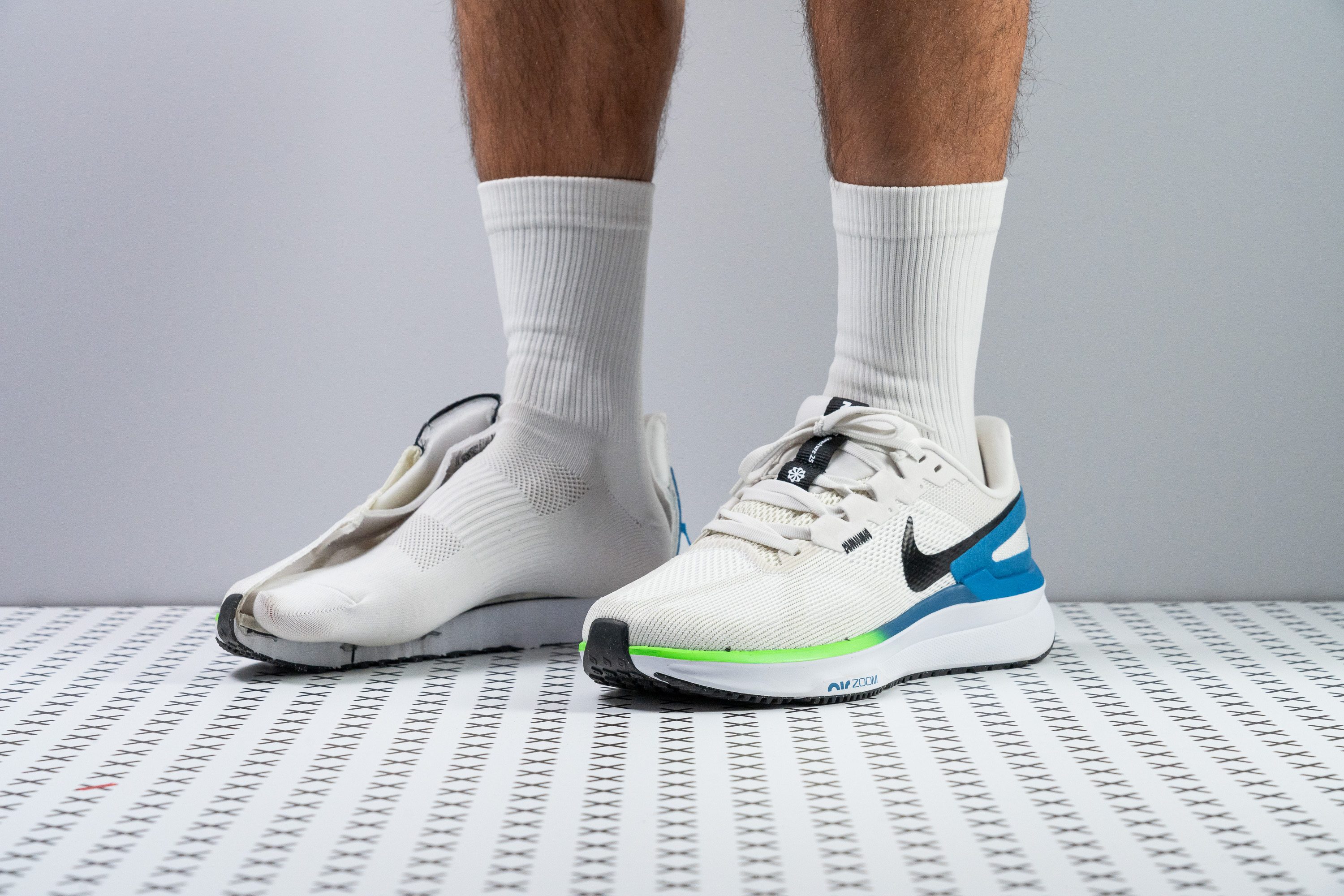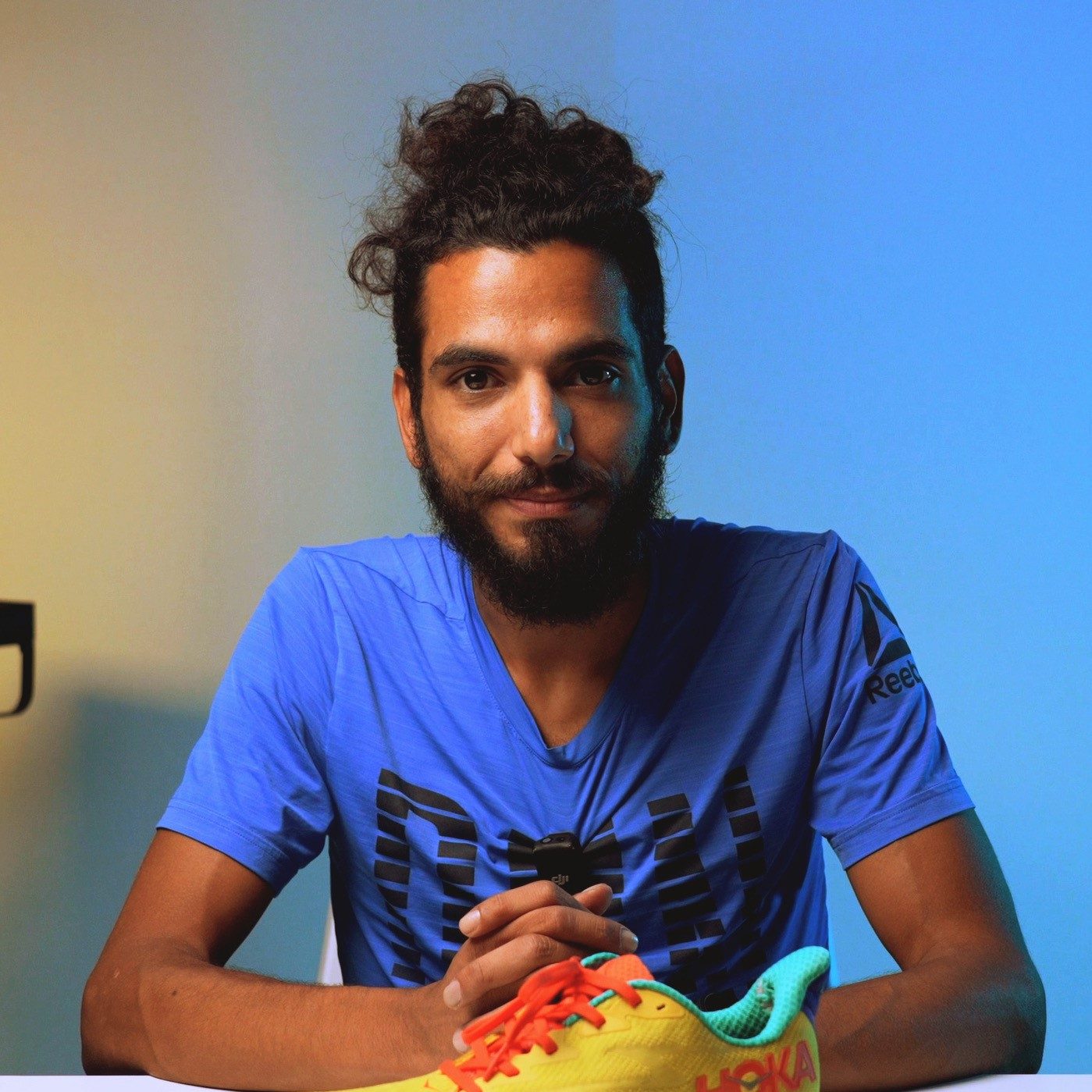Our verdict
Pros
- Stable and supportive ride
- Plush and protective cushioning
- Consistent in the cold
- Good for long slow distance runs
- No break-in required
- Durable, high-quality upper
- Lots of colorway options
Cons
- Quite heavy
- Average breathability at best
- Clunky at high paces
Audience verdict
- Top 23% most popular running shoes
Comparison
The most similar running shoes compared
+ + Add a shoe | |||||
|---|---|---|---|---|---|
| Audience score | 82 Good! | 84 Good! | 80 Good! | 85 Good! | |
| Price | $140 | $145 | $125 | $140 | |
| Pace | Daily running | Daily running | Daily running | Daily running | |
| Shock absorption | High | High | High | Moderate | |
| Energy return | Low | Moderate | Moderate | Moderate | |
| Traction | Moderate | Moderate | High | High | |
| Arch support | Stability | Stability | Stability | Stability | |
| Weight lab Weight brand | 10.7 oz / 302g 11.4 oz / 322g | 10.4 oz / 296g 10.5 oz / 298g | 8.1 oz / 231g 8 oz / 228g | 10.4 oz / 295g 10.5 oz / 298g | |
| Lightweight | ✗ | ✗ | ✓ | ✗ | |
| Drop lab Drop brand | 12.1 mm 10.0 mm | 10.1 mm 10.0 mm | 9.4 mm 5.0 mm | 9.3 mm 8.0 mm | |
| Strike pattern | Heel | Heel | HeelMid/forefoot | HeelMid/forefoot | |
| Size | True to size | Slightly small | Slightly small | Slightly small | |
| Midsole softness | Soft | Soft | Soft | Soft | |
| Difference in midsole softness in cold | Small | Small | Big | Big | |
| Toebox durability | Good | Decent | Bad | Decent | |
| Heel padding durability | Good | Good | Decent | Bad | |
| Outsole durability | Good | Good | Bad | Decent | |
| Breathability | Moderate | Moderate | Breathable | Moderate | |
| Width / fit | Medium | Medium | Narrow | Medium | |
| Toebox width | Medium | Medium | Narrow | Medium | |
| Stiffness | Moderate | Moderate | Moderate | Moderate | |
| Torsional rigidity | Stiff | Stiff | Stiff | Moderate | |
| Heel counter stiffness | Stiff | Moderate | Stiff | Stiff | |
| Rocker | ✗ | ✗ | ✓ | ✗ | |
| Heel lab Heel brand | 36.7 mm 37.0 mm | 36.1 mm 38.0 mm | 36.0 mm 33.0 mm | 36.8 mm 38.0 mm | |
| Forefoot lab Forefoot brand | 24.6 mm 27.0 mm | 26.0 mm 28.0 mm | 26.6 mm 28.0 mm | 27.5 mm 30.0 mm | |
| Widths available | NarrowNormalWideX-Wide | NormalWideX-Wide | NormalWide | NarrowNormalWideX-Wide | |
| Orthotic friendly | ✓ | ✓ | ✓ | ✓ | |
| Season | All seasons | All seasons | SummerAll seasons | All seasons | |
| Removable insole | ✓ | ✓ | ✓ | ✓ | |
| Ranking | #523 Bottom 20% | #247 Bottom 33% | #304 Bottom 18% | #215 Bottom 42% | |
| Popularity | #146 Top 23% | #52 Top 14% | #87 Top 24% | #32 Top 9% |
Who should buy
We recommend the Nike Structure 25 as an excellent choice for:
- Overpronating runners who want a comfy yet stable daily trainer that rides like a neutral shoe
- Heel strikers in the market for a responsive and well-cushioned road shoe that's versatile enough to tackle recovery runs as well as long-distance efforts.
- Broad-footed runners who need a toebox with some added internal real estate
- Runners in colder climates looking for a warm shoe that performs consistently no matter how low temperatures drop
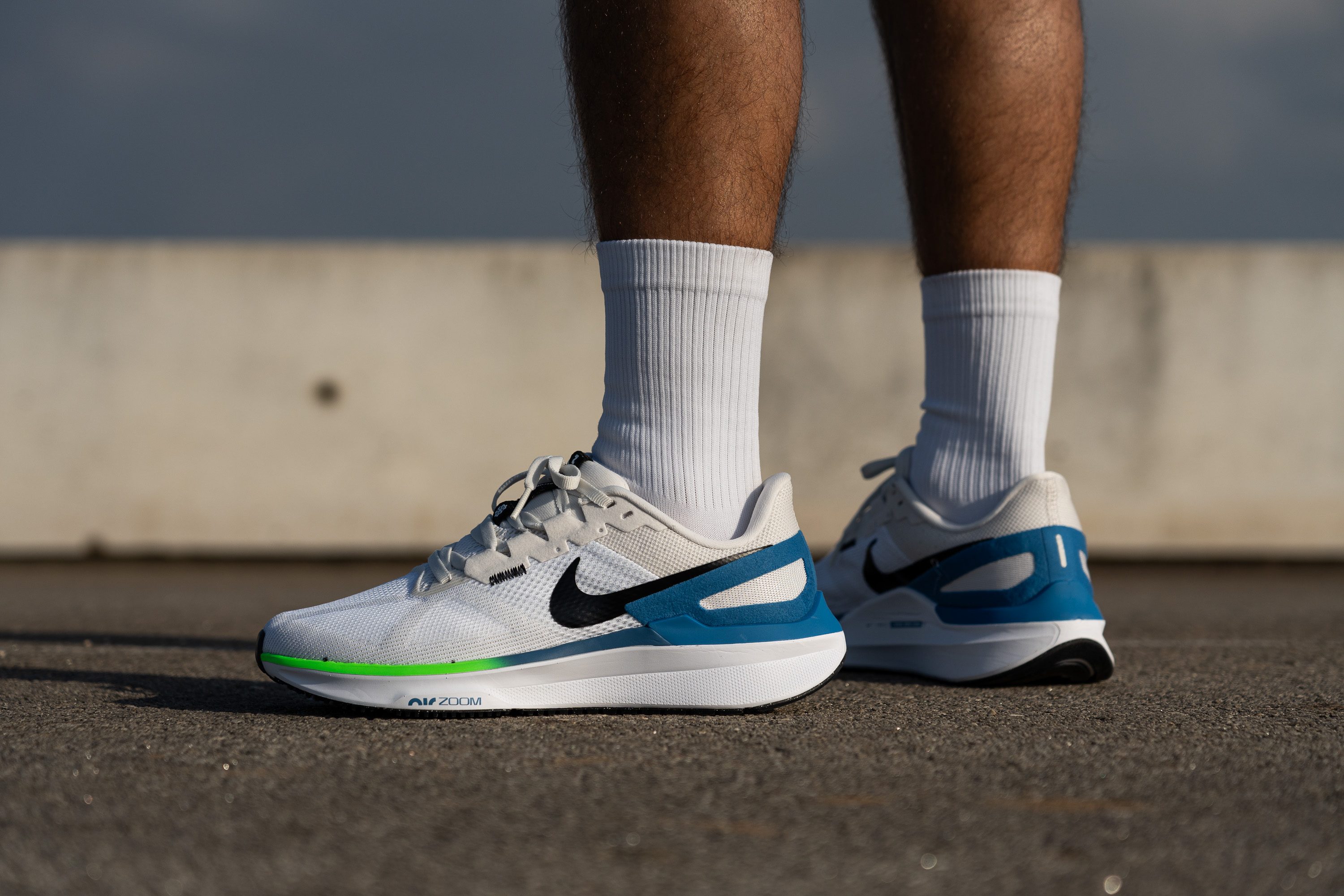
Who should NOT buy
While stated to have a 10 mm heel drop, we found the Structure 25 to have an even steeper offset of 12.1 mm. While this is conducive for heel strikers and those with lower leg issues, we recommend that those with a forefoot striking stride go for a shoe with a lower drop like like the Hoka Arahi 6.
The Structure 25's toebox may prove to be a little too roomy for those with narrow feet. We recommend either sizing down slightly for a more snug fit or looking at a less spacious alternative like the ASICS Gel Kayano 30.
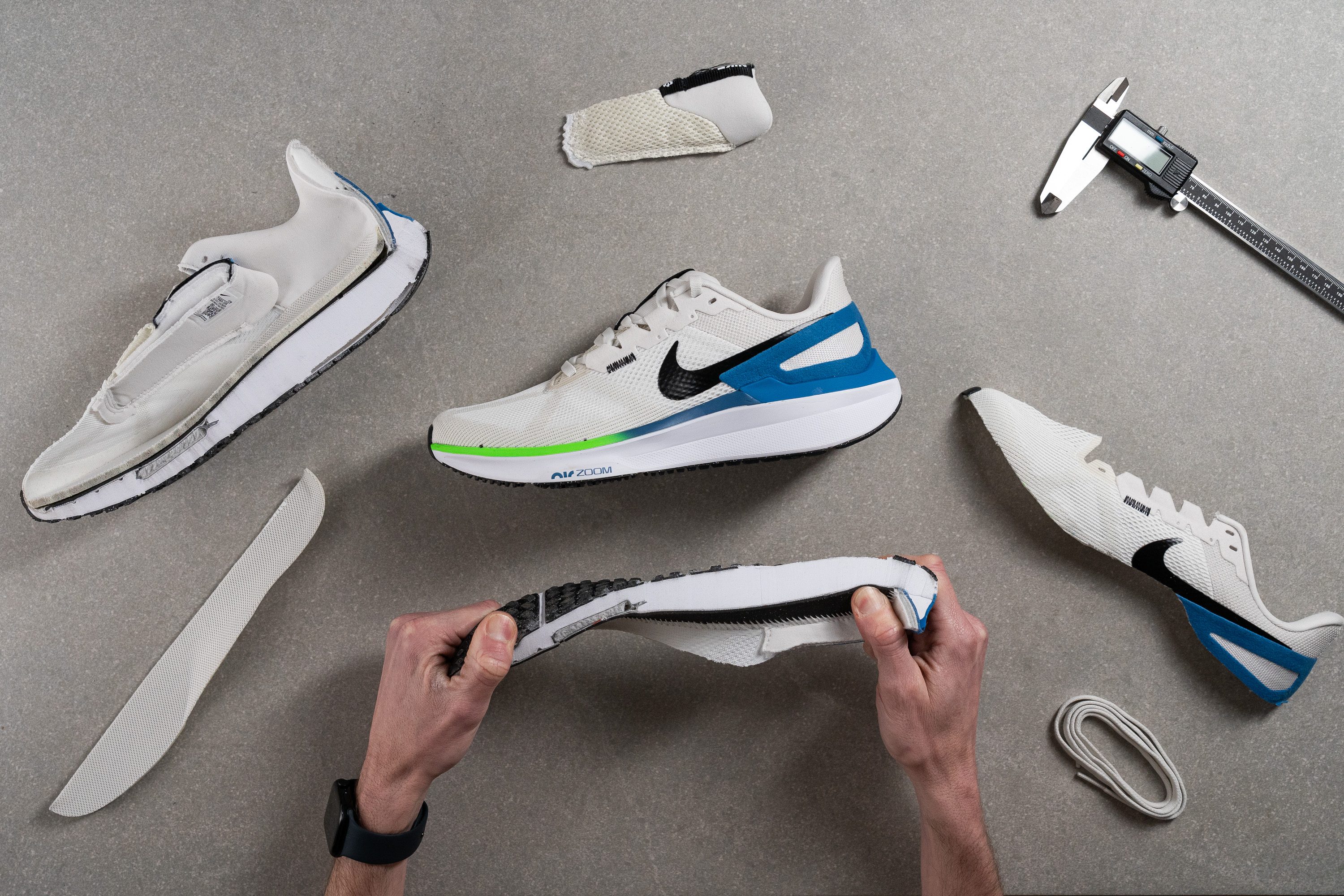
While its Cushlon 3.0 midsole feels quite responsive underfoot, we found that the Structure 25 lacks the energy return and is a little too heavy to facilitate speedier runs. The Saucony Tempus feels snappier underfoot and is better suited for high-paced sessions.
Although the Structure 25 does boast a fair amount of airflow, its generous padding and dense upper mesh mean that it feels quite toasty on warmer days. For a more breezy alternative that doesn't turn into a sweatbox as the mercury rises, we recommend checking out the Brooks Adrenaline GTS 23 instead.
Cushioning
Shock absorption
The Structure 25 feels like a solid pick for daily runs and can handle long outings too. We noticed that from our first strides, and lab testing confirmed it with a solid 131 SA in shock absorption.
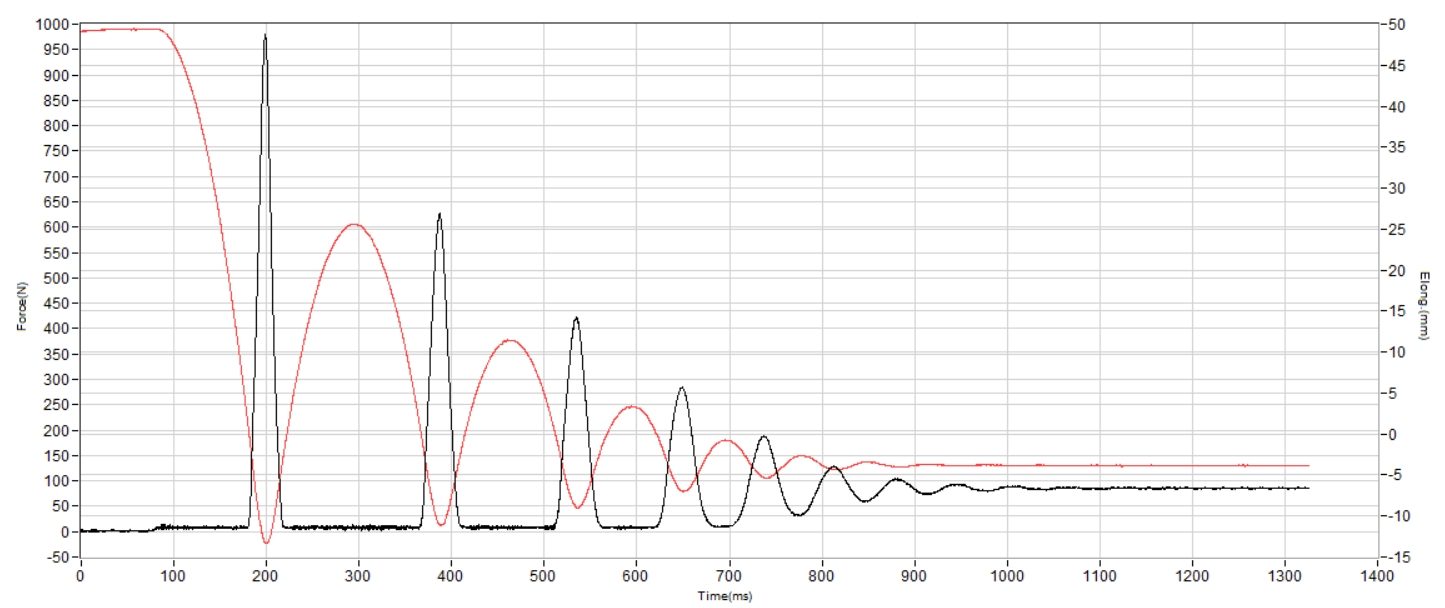
| Structure 25 | 131 SA |
| Average | 129 SA |
Energy return
Energy return isn’t the standout feature here, but that’s never been the point of the Structure series. We found 53.0% in the heel—acceptable for a stability-focused shoe—while forefoot strikers get a slightly livelier 58.4%, still below average.
| Structure 25 | 53.0% |
| Average | 58.5% |
Heel stack
Using our caliper, we measured the Structure 25's stack to be 36.7 mm thick at the heel which makes the 37 mm stated by Nike quite accurate. We like to see that here in the lab.
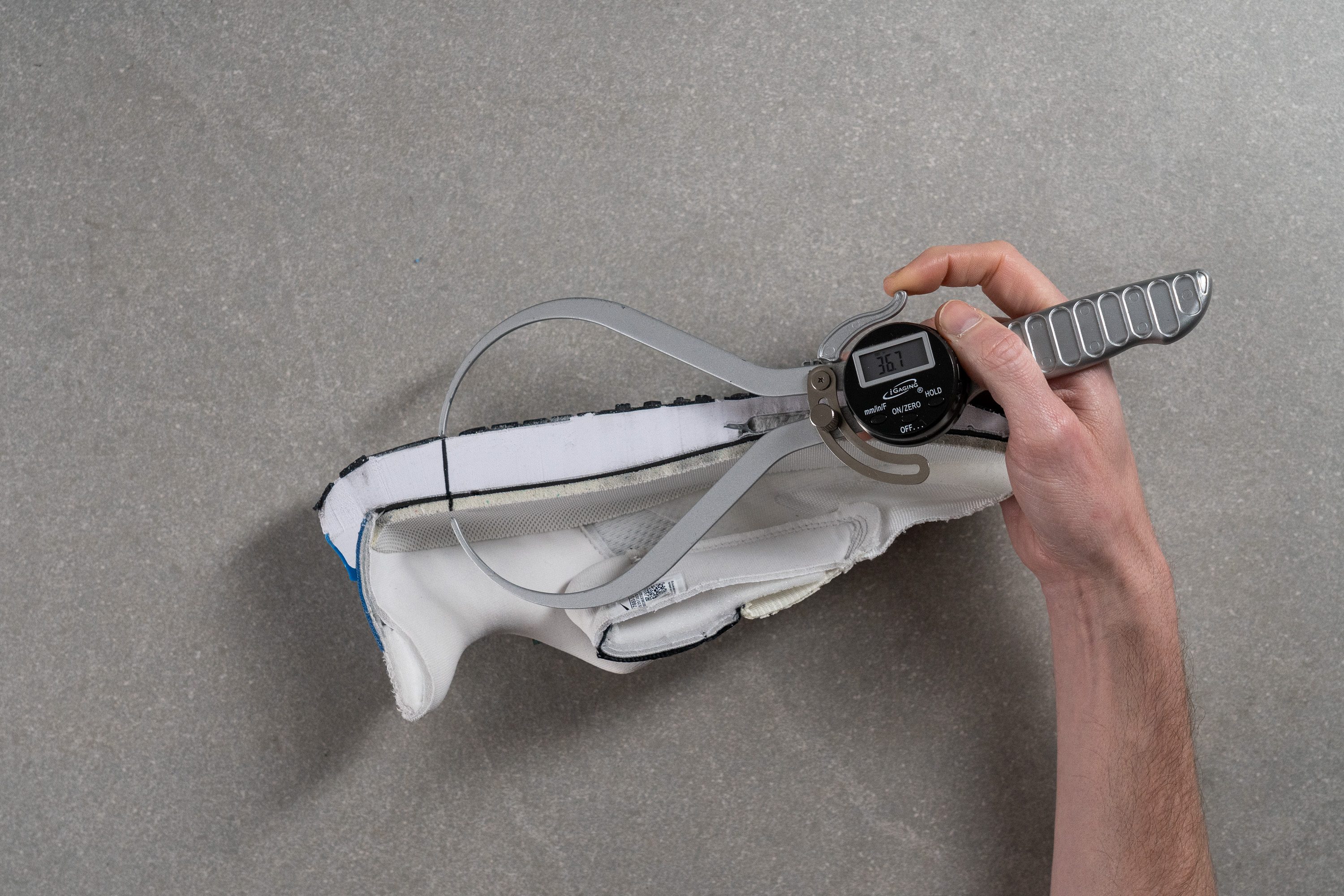
Having this amount of foam underfoot isn't just good for heel strikers, but is suitable in general for long distances where most runners tend to revert to heel landings as fatigue sets in. Furthermore, it really allows us to sink into and savor Nike's Cushlon 3.0 midsole foam during our test runs.
| Structure 25 | 36.7 mm |
| Average | 34.8 mm |
Forefoot stack
Nike wasn't as accurate with their forefoot stack measurement of 27 mm as we found that there is actually only 24.6 mm of foam in that part of the midsole according to our caliper.
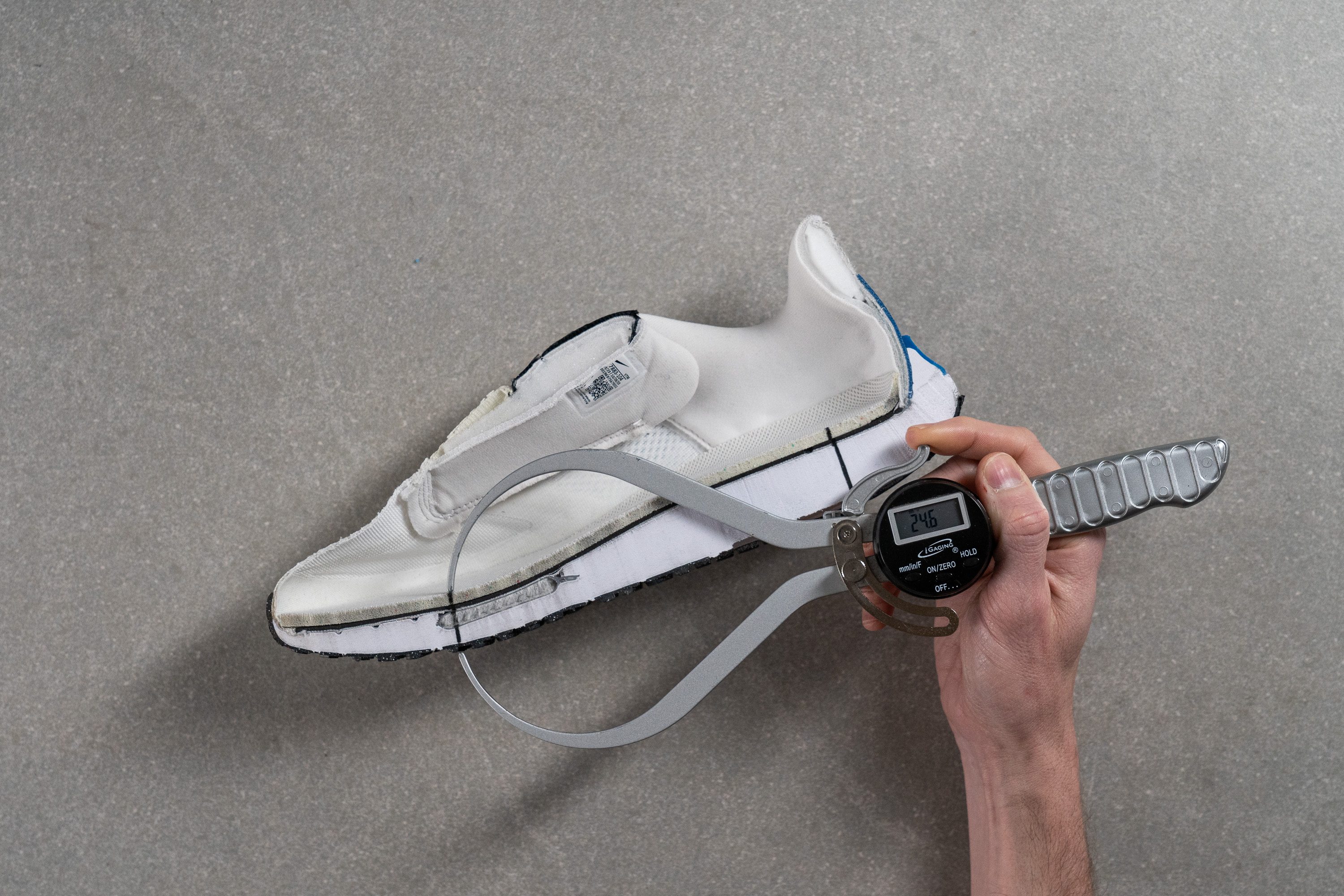
This is still an average amount of foam at the forefoot for a road shoe and means that we enjoyed comfy forefoot landings as well while testing this shoe.
| Structure 25 | 24.6 mm |
| Average | 26.2 mm |
Drop
The discrepancy with the forefoot measurement means that the Structure 25 has a heel drop of 12.1 mm as opposed to the 10 mm as stated by Nike. This isn't totally out of the norm for us here in the lab as we've come across many similar deviations while testing shoes as explored in this article. Nevertheless, this still puts the Structure 25 in the category of high-drop shoes that tend to favor runners with a heel-striking stride or those with calf or lower leg issues as it puts more load on our hips and knees.
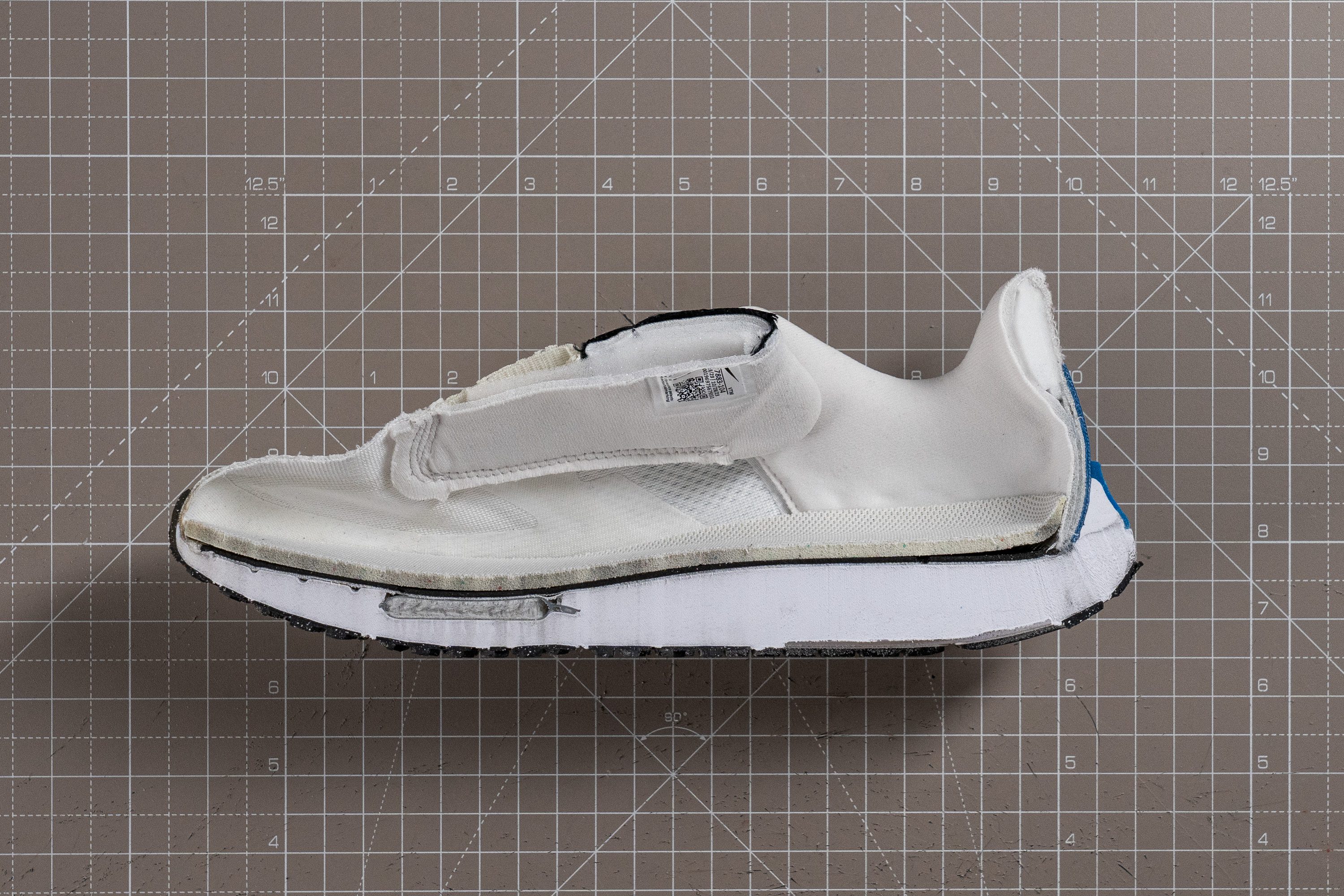
While we believe that midfoot strikers should still get some benefit out of this shoe, this steep offset means that forefoot strikers won't be able to appreciate all the Structure 25 has to offer. For those runners, we recommend going for a shoe with a lower drop like the Saucony Tempus (8.5 mm) or the Hoka Arahi 6 (4.1 mm) instead.
| Structure 25 | 12.1 mm |
| Average | 8.6 mm |
Midsole softness
One thing we love about the Structure 25 is its comfy yet supportive ride that doesn't feel like your typical stability shoe. It pampers our feet in the right ways while subtly guiding us towards a more neutral stride. What's more, it feels great out of the box but ages like a fine wine and feels even better after a few runs.
Pressing our durometer against the Cushlon 3.0 midsole gives us quite a plush reading of 17 HA. When combined with the shoe's robust stack, this explains the soft and pillowy landings we enjoyed while testing the Structure 25.
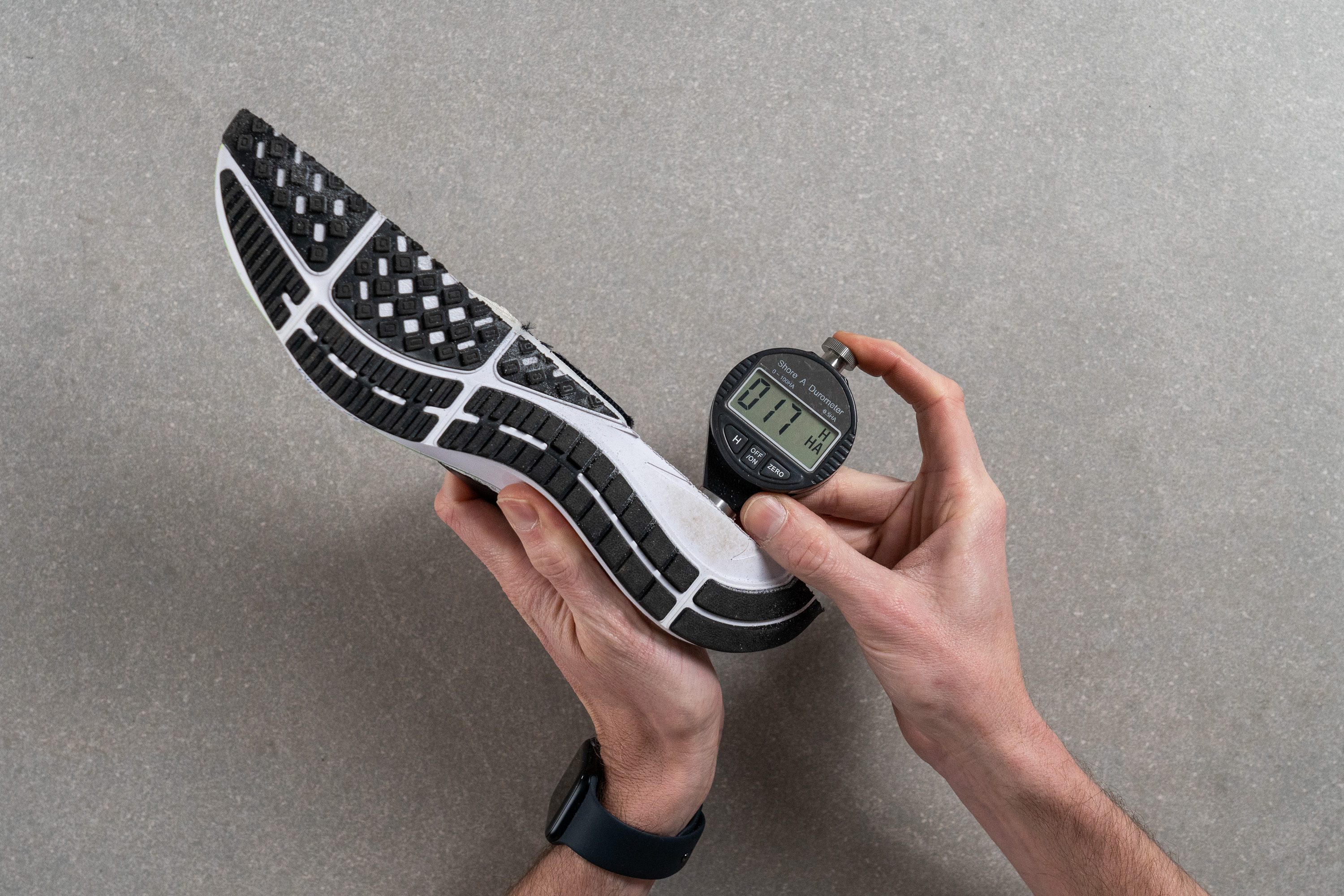
However, the Air Zoom unit embedded in the forefoot means that the midsole doesn't feel as cushy in this part of the shoe, with the trade-off being a little extra pep to our toe-offs. It's not crazy springy but it was a welcome amount of energy return during our longer runs.
| Structure 25 | 17.0 HA |
| Average | 20.4 HA |
Size and fit
Size
Nike Structure 25 fits true to size (144 votes).
Width / Fit
The Structure 25 boasts an average fit that we measured to be 94.6 mm wide at its widest point.
This makes it just a tiny bit less broad than our current lab average, which means that it should provide an accommodating fit for most runners, including those with narrow feet.
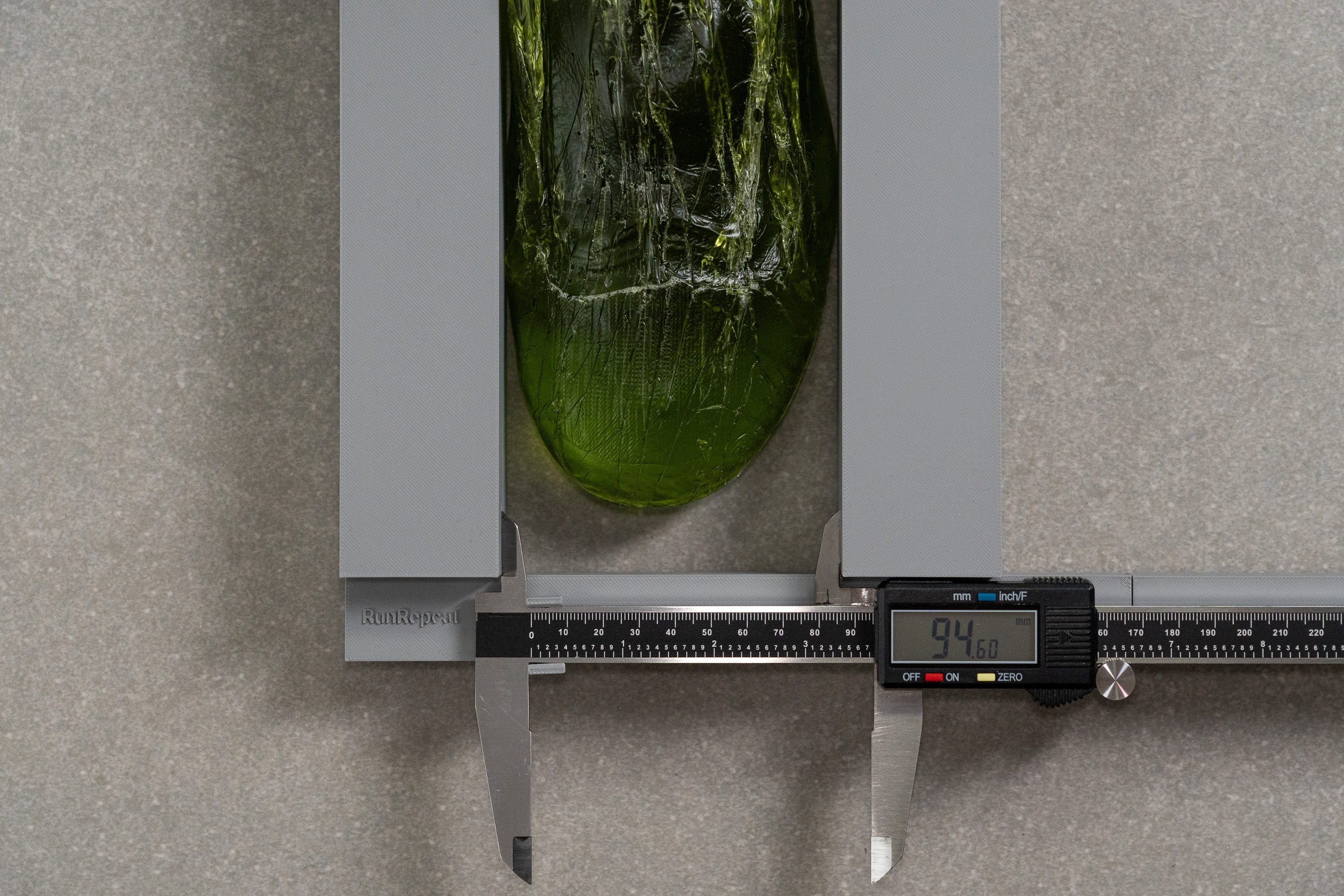
| Structure 25 | 94.6 mm |
| Average | 95.1 mm |
Toebox width
In the toebox, we recorded a width of 73.6 mm, which perfectly matched our experience while testing the Structure 25. Neither overly spacious nor tightly constrained, it offers an average fit with a well-balanced design for most individuals.
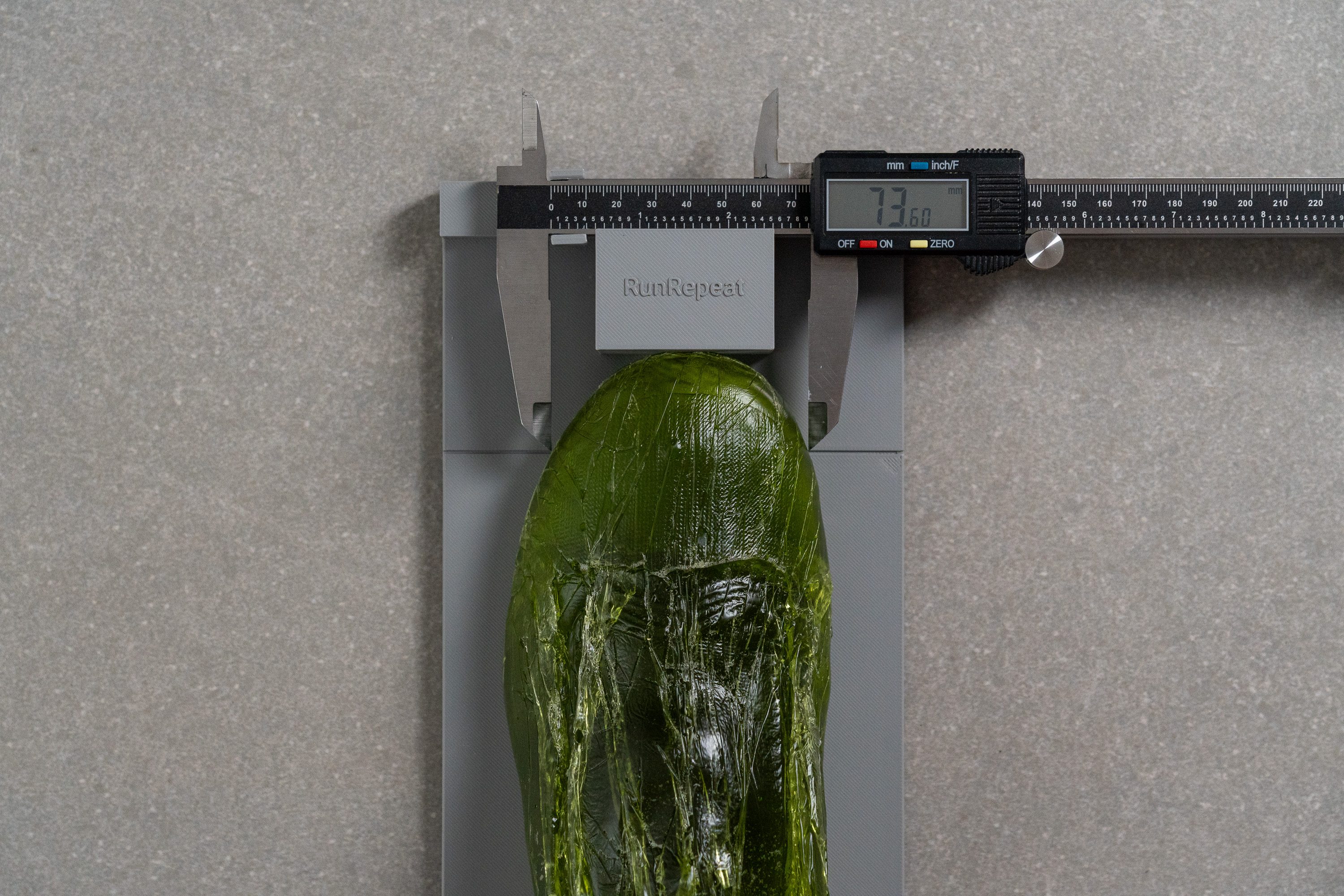
| Structure 25 | 73.6 mm |
| Average | 73.3 mm |
Toebox height
We discovered ample space for toe movement during our runs, and later in the lab, we measured 28.9 mm—confirming our initial impressions.
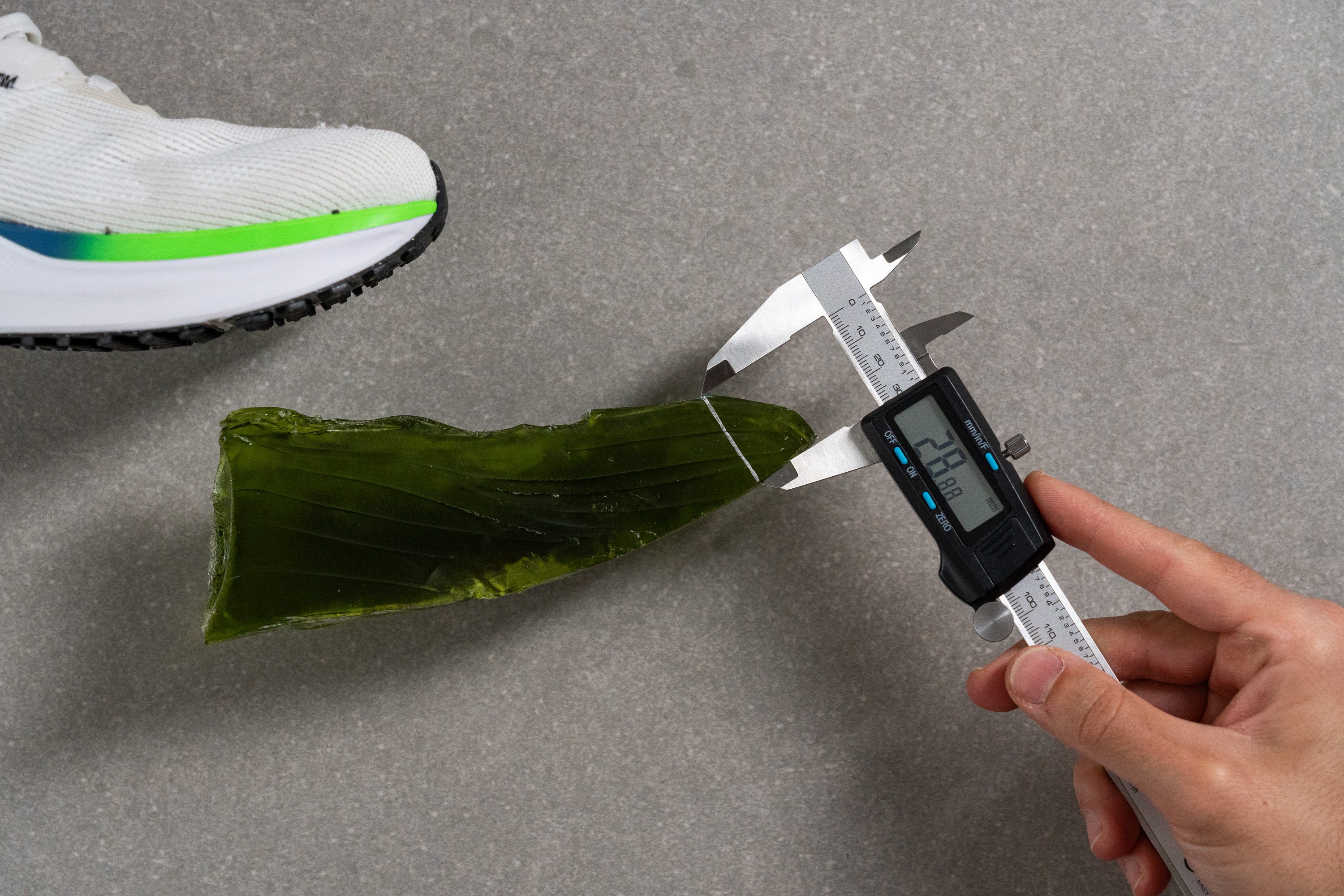
| Structure 25 | 28.9 mm |
| Average | 27.1 mm |
Traction / Grip
Traction test
We tested the Structure 25 and found the grip surprisingly dependable—never causing us to hesitate, even after a quick downpour. Our lab-based SATRA TM144 test confirmed our impression with a 0.43 score, reflecting solid, all-weather, everyday traction!
| Structure 25 | 0.43 |
| Average | 0.48 |
Outsole design
The outsole of the Structure 25 mirrors the Pegasus layout with full-length rubber coverage and a classic waffle-inspired pattern. Nike added a durable medial post area for extra support, true to its stability DNA.
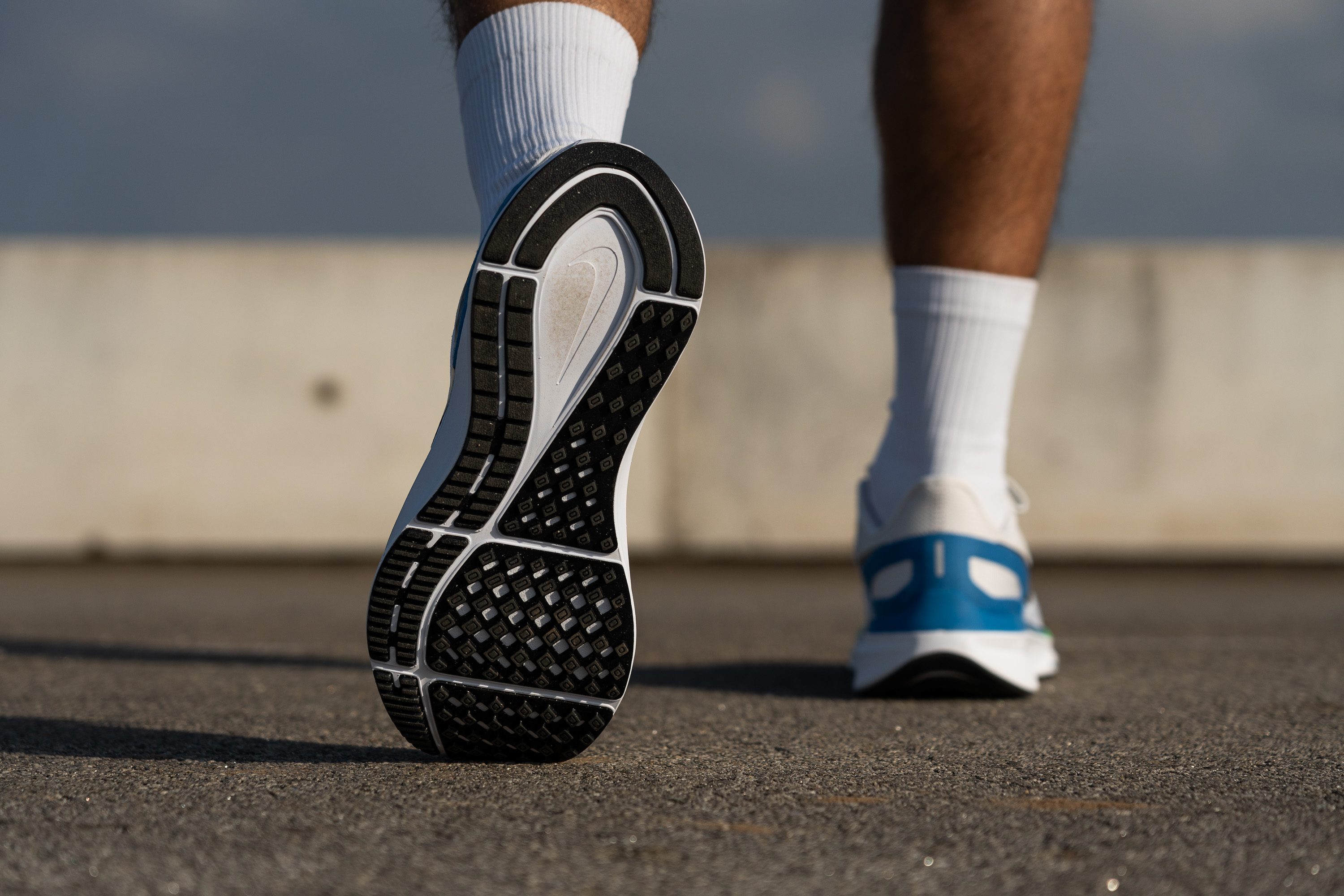
Flexibility / Stiffness
Despite its relatively high level of torsional rigidity, we discovered that the Structure 25 is somewhat pliable in a longitudinal sense. We used our custom machine to bend the shoe and found that 15.2N of force is required to get it to 90 degrees, which is around the average.

| Structure 25 | 15.2N |
| Average | 15.3N |
Weight
In spite of the aforementioned weight-saving measure, the Structure 25 still tips our scale at a heavier-than-average 10.7 oz (302g). However, this is still on par with the average stability shoes and doesn't feel overly burdensome underfoot, especially when it comes to easier paces.
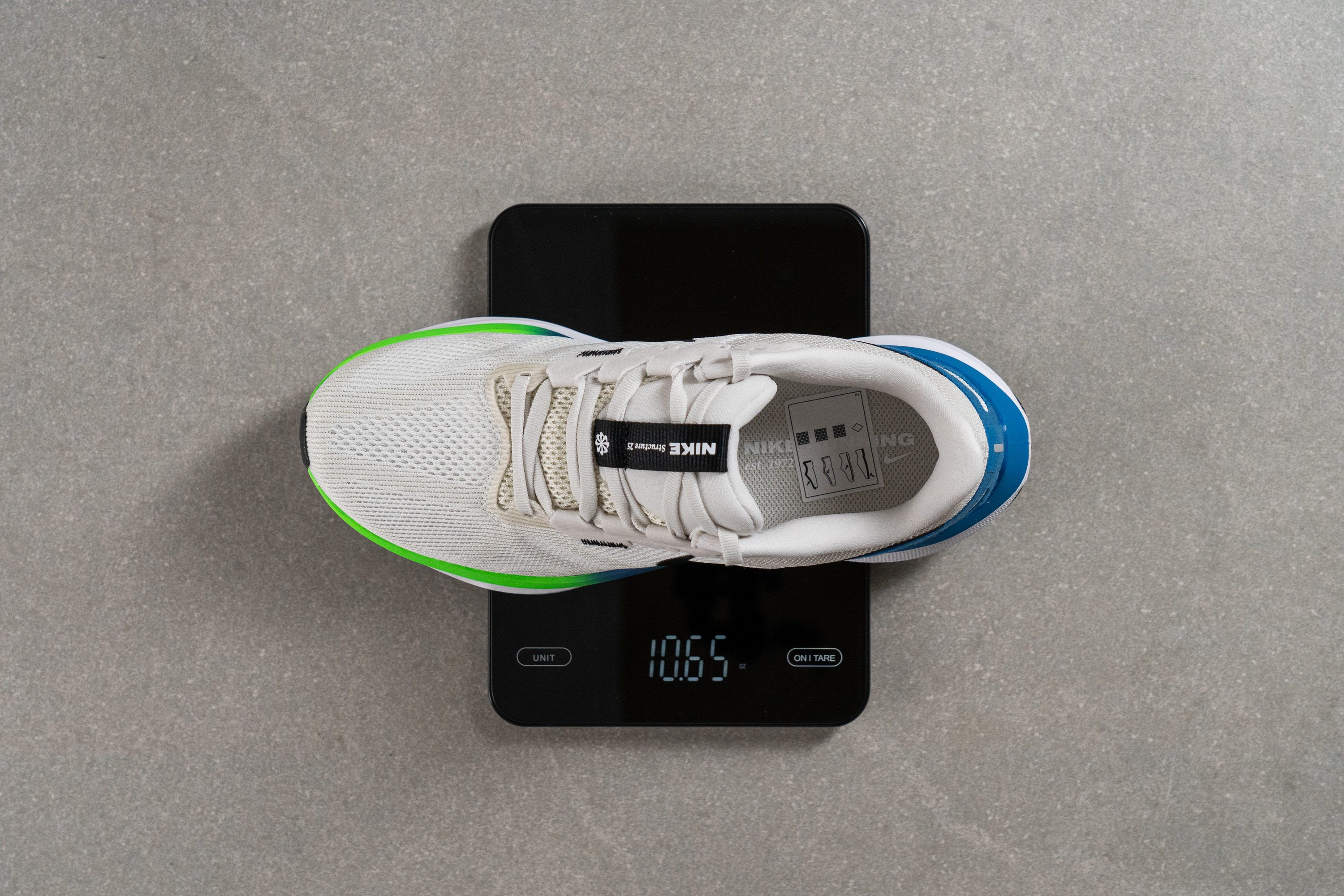
| Structure 25 | 10.7 oz (302g) |
| Average | 9.3 oz (264g) |
Breathability
To test the breathability of the shoe, we pumped the Structure 25 full of smoke to see how easily it vents through the upper. As the footage demonstrates, it takes quite a long while before any smoke is able to filter out of the shoe. Eventually, a light haze emerges and flows steadily, albeit in rather thin wisps, throughout the shoe. This leads us to give the Structure a middle-of-the-road score of 3 out of 5 for breathability. This is, no doubt, thanks in part to the generous amount of thick padding throughout the shoe which does feel quite warm as we take the shoe for test runs.
However, how easily the light shines through a backlit cross-section of the shoe's upper over a backlight would lead us to believe otherwise as we've found that this is usually an indicator of good breathability.
Our microscope lays our questions to rest as it reveals how densely woven the Structure 25's multi-layered upper mesh is. We only see very small visible gaps in between the braids that go all the way through and promote some level of airflow. This explains the smoke's delayed ability to start filtering out of the shoe in our first assessment.
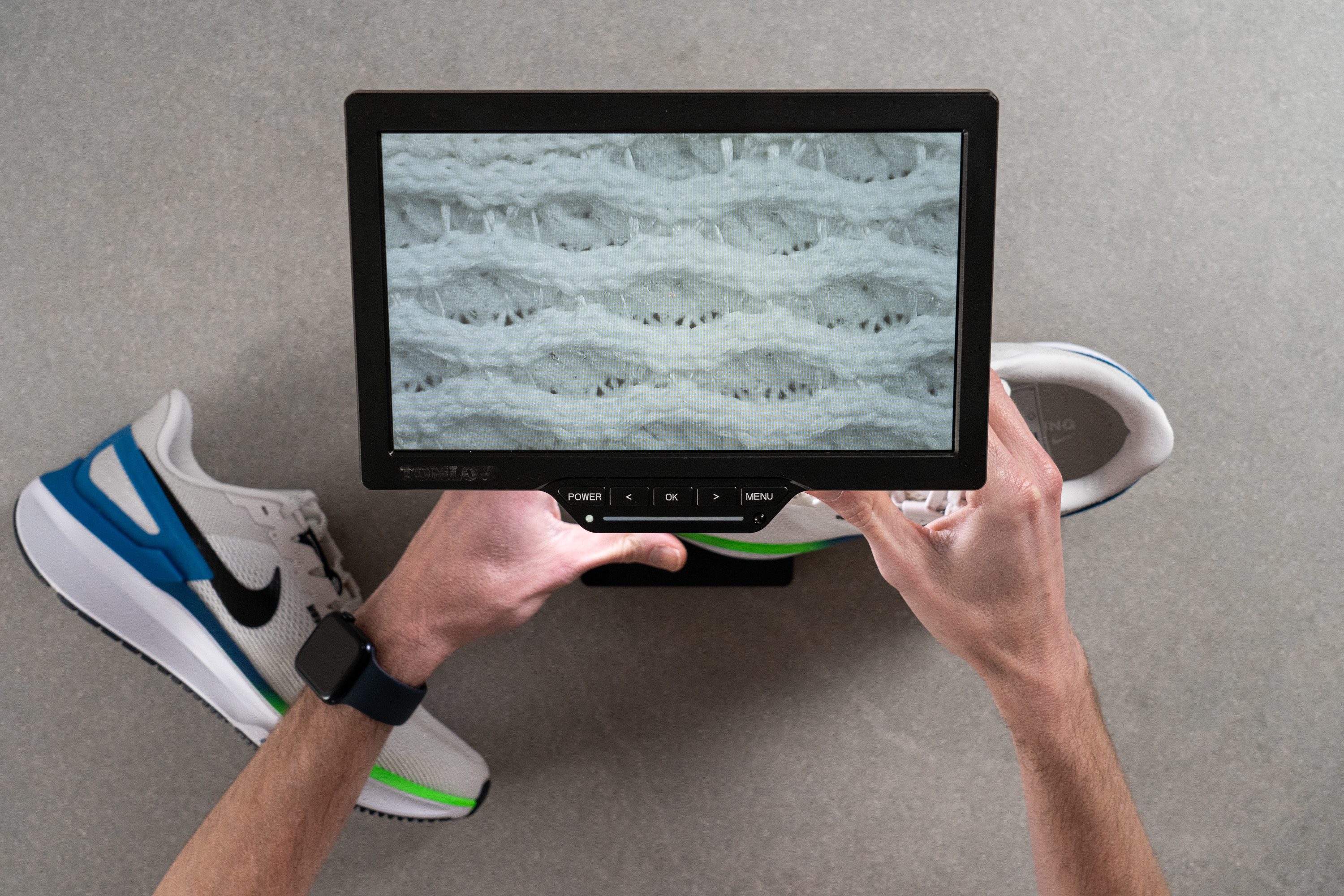
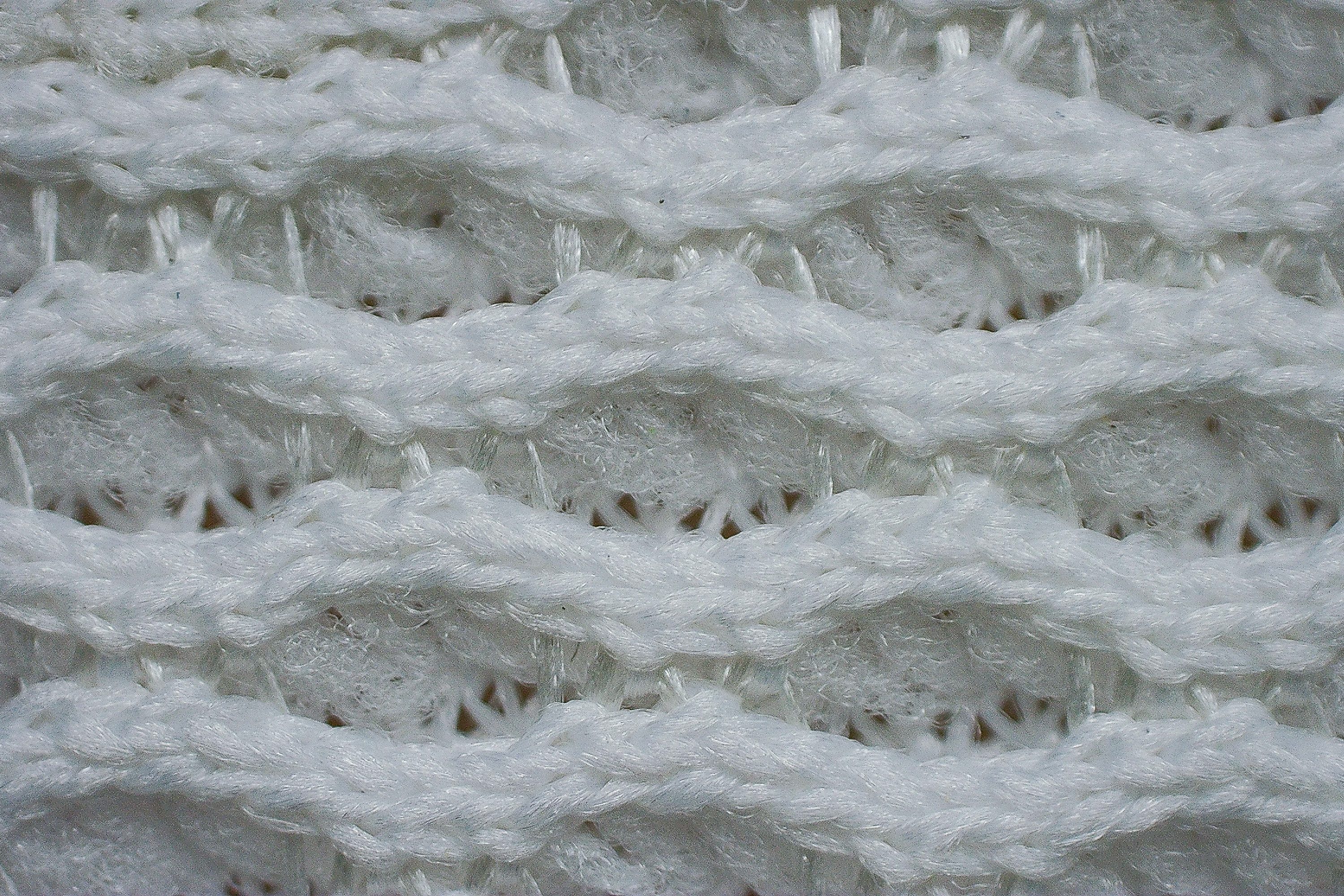
| Structure 25 | 3 |
| Average | 3.7 |
Stability
Lateral stability test
Incredibly for a shoe that doesn't use any rigid medial posts or shanks in its construction, the Structure 25 manages to feel incredibly stable underfoot as it gently nudges us towards a more neutral gait. We'll explore the factors that play into this steady ride over the next few tests.
Torsional rigidity
We found the Structure 25 to be quite difficult to bend and twist manually, leading us to give it a subjective torsional rigidity score of 4 out of 5. As such, the shoe is able to maintain a nice and level landing surface by resisting any excessive lateral movements of our foot.
| Structure 25 | 4 |
| Average | 3.5 |
Heel counter stiffness
The heel counter is also quite stiff, earning another score of 4 out of 5 in our manual assessment.
This strong structure in combination with the generous amount of padding back there presents a good balance of stability and comfort as it locks our rearfoot in place and mitigates rolling without putting too much on our heels or tendons.
| Structure 25 | 4 |
| Average | 2.9 |
Midsole width - forefoot
Another big factor in the Structure 25's well-balanced ride is its broad base. Using our caliper, we measured its midsole to be 116.4 mm wide at the forefoot which is quite a bit wider than average.
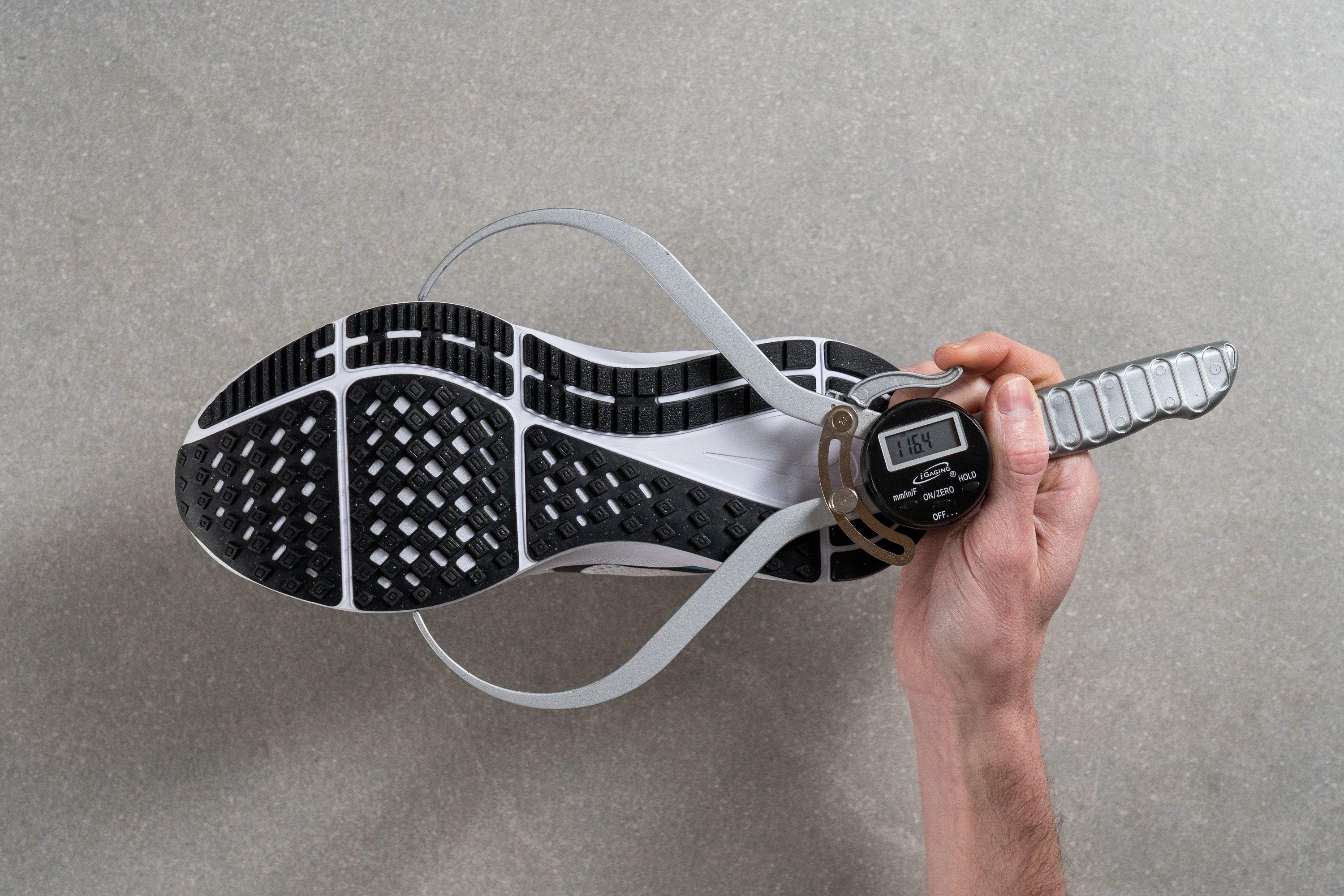
| Structure 25 | 116.4 mm |
| Average | 114.4 mm |
Midsole width - heel
At 95.3 mm wide according to our caliper measurements, the midsole is even wider at the heel when compared to our lab average. This gives heel strikers a robust landing platform that will surely keep them feeling surefooted with every stride.
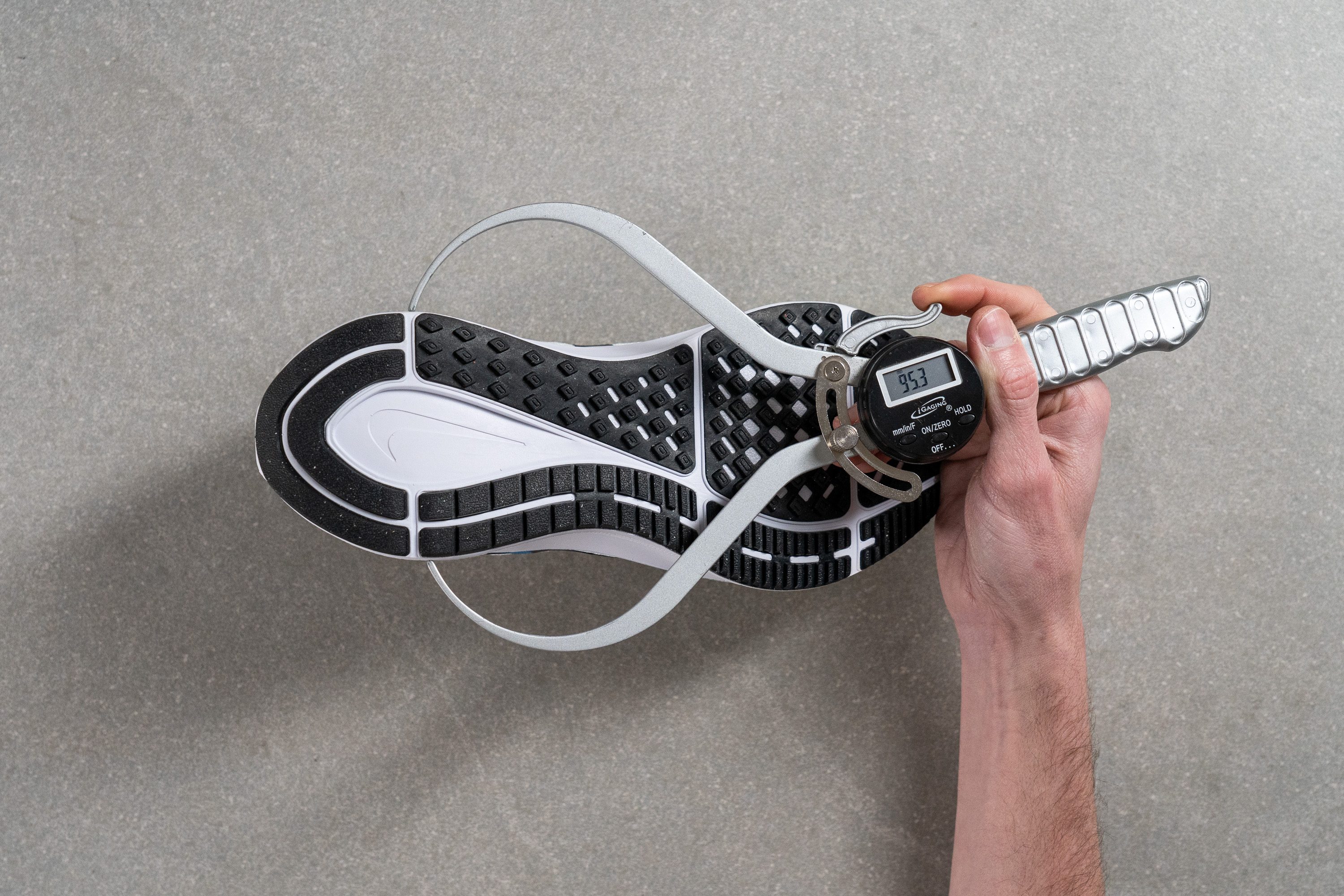
| Structure 25 | 95.3 mm |
| Average | 90.7 mm |
Durability
Toebox durability
To simulate extreme wear and tear, we fired up our Dremel to 5K RPM and set it against the Structure 25's toebox with 3.2N of force.
After four seconds of grinding, we found that our tool had an insignificant effect on the shoe's mesh as the damage left behind is barely noticeable. This stellar performance leads us to give the Structure 25 a toebox durability of 5 out of 5.
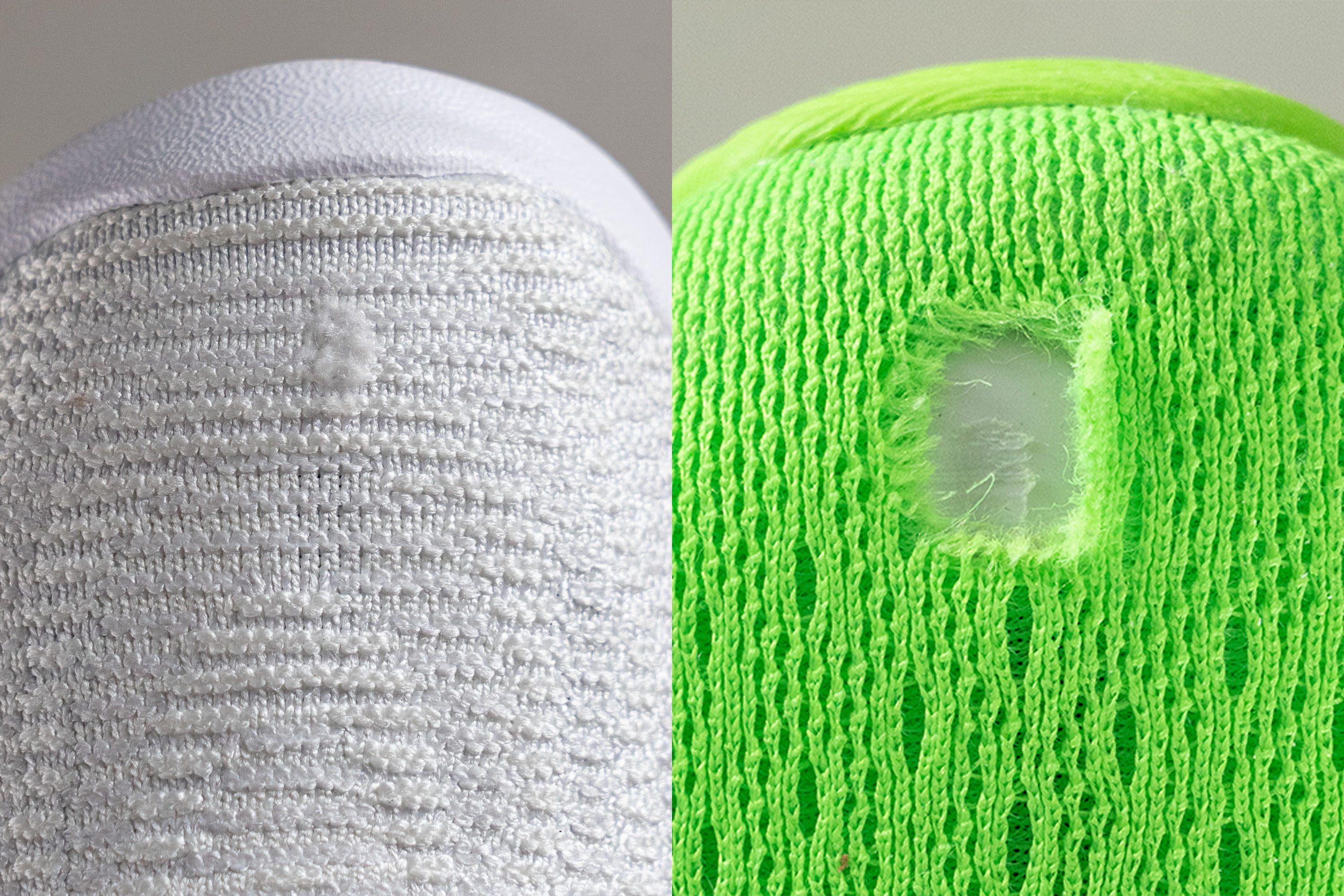
Compare that to the abysmal performance of the ASICS Gel Pulse 13 which had its toebox obliterated in this same test.
| Structure 25 | 5 |
| Average | 2.6 |
Heel padding durability
The heel collar proved to be almost as hardy as the toebox in its face off against our Dremel.
While our tool was able to menace the lining to a certain extent, it wasn't able to pierce through it and reach the soft padding within. As such, we give the Structure 25 a heel padding durability score of 4 out of 5. This is excellent for a daily trainer and means that no amount of heel rubbing, even when going sockless, will significantly compromise the shoe's comfort or lockdown at the rearfoot.
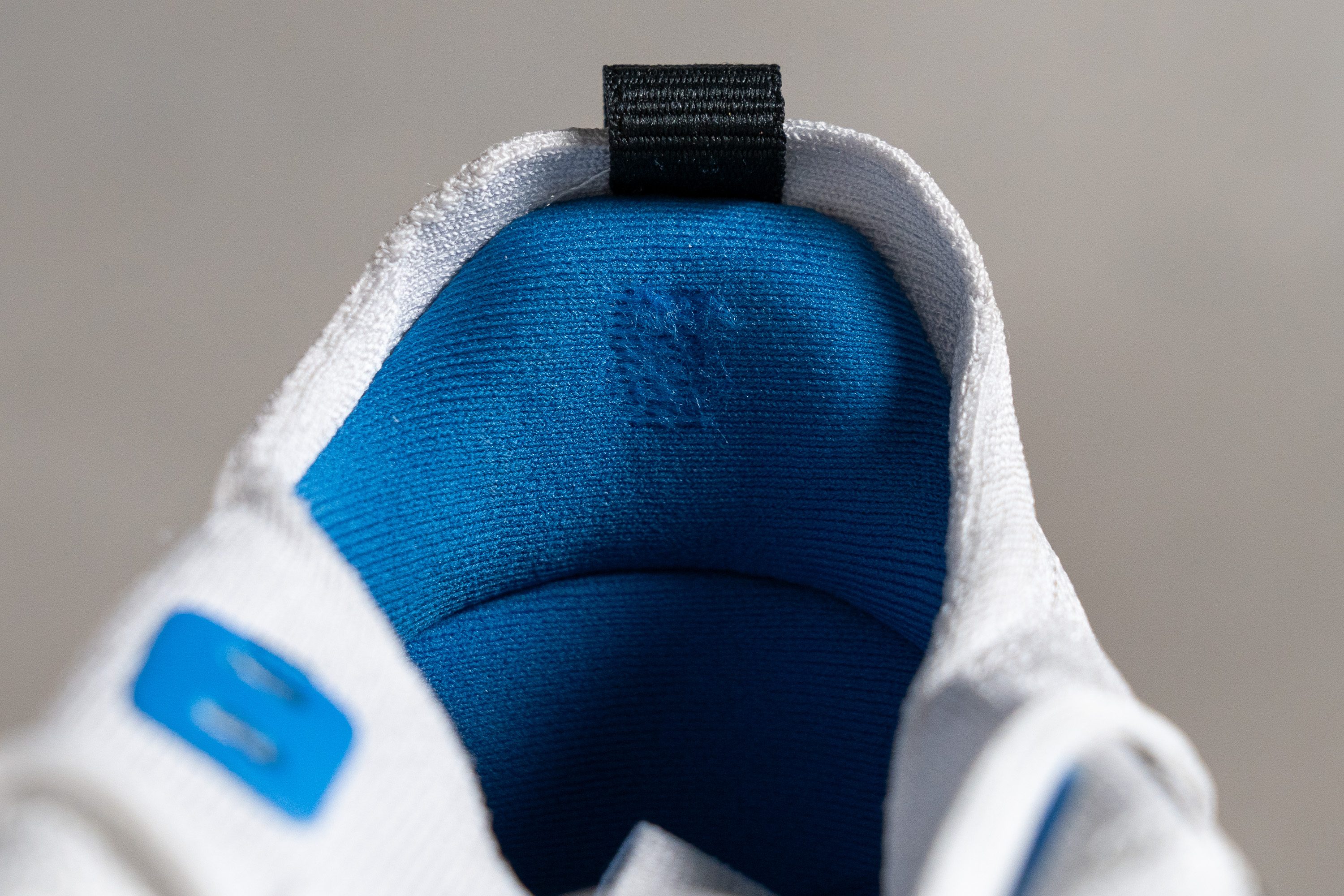
| Structure 25 | 4 |
| Average | 3.4 |
Outsole hardness
Pressing our durometer against the Structure 25's outsole yields a reading of 88.5 HC. This is quite a bit harder than our current lab average which bodes well regarding the outsole's longevity.

| Structure 25 | 88.5 HC |
| Average | 79.2 HC |
Outsole durability
Now spinning at 10K RPM, we set our Dremel against the outsole for a grand total of twenty-two seconds of abrasive force.
Afterward, we used a tire tread gauge to measure the indentation left behind in the wake of the test and found that 0.8 mm of rubber had been worn away. This isn't quite as durable as we had anticipated based on the hardness of the rubber but still puts the Structure 25 on par with our current lab average. We therefore expect this shoe to last the expected shelf life of 400 to 500 miles before any significant signs of wear and tear appear.
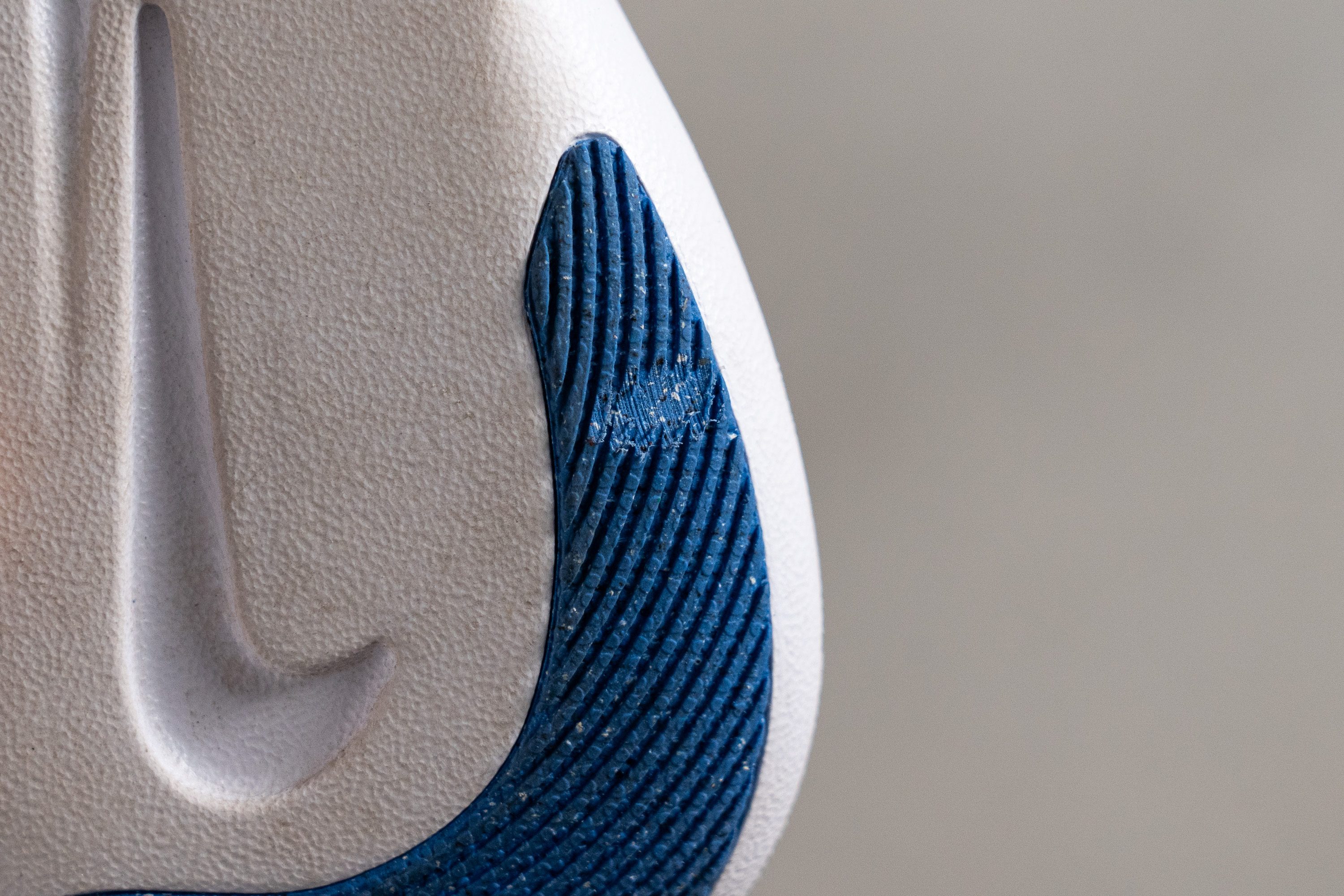
| Structure 25 | 0.8 mm |
| Average | 1.1 mm |
Outsole thickness
The Structure 25's outsole isn't as robust as our current lab average at only 2.3 mm thick according to our caliper measurements.
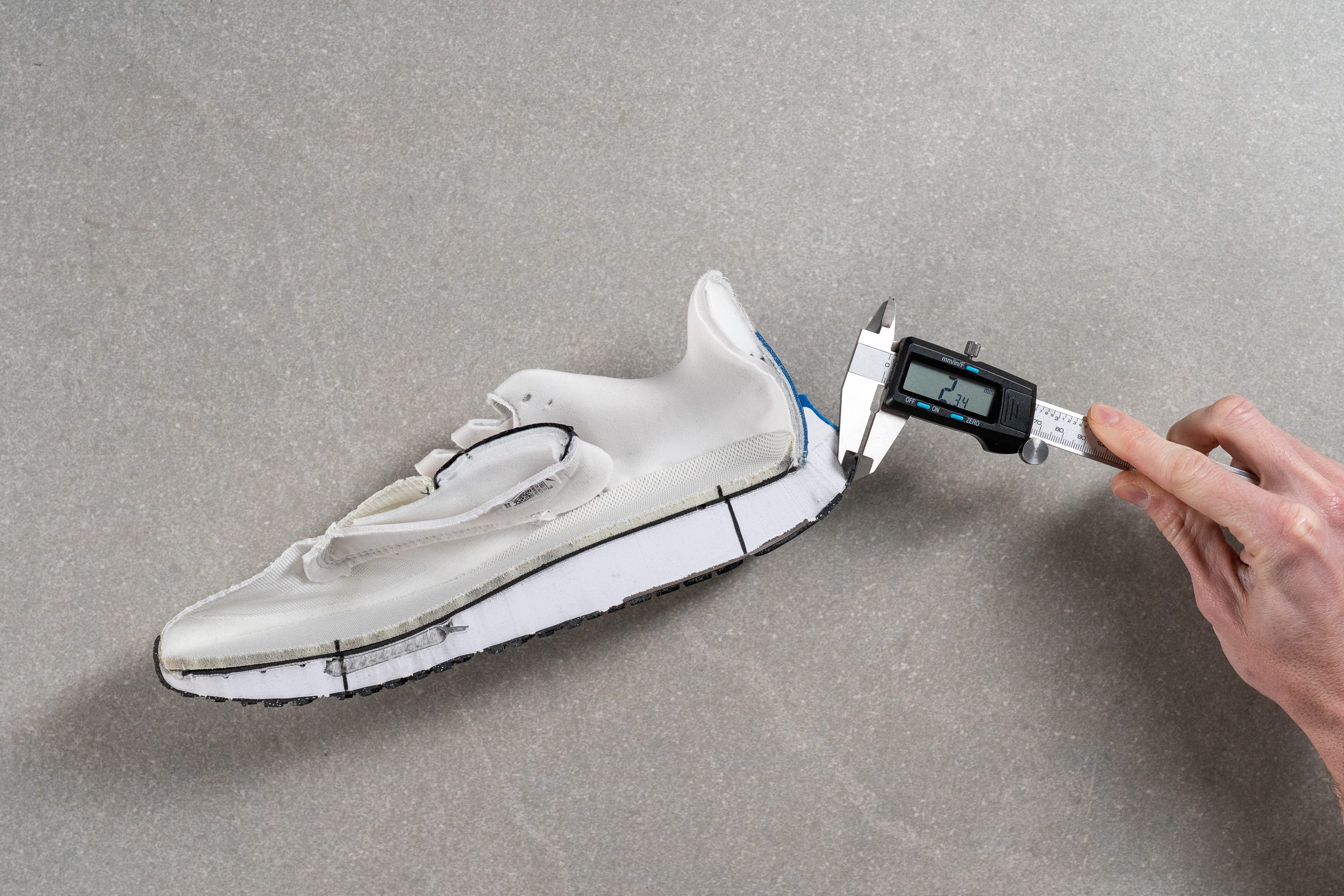
This, along with the decision to go for incomplete coverage of the midsole, is surely a decision made with shedding weight off the shoe.

| Structure 25 | 2.3 mm |
| Average | 3.2 mm |
Misc
Insole thickness
At 5 mm thick according to our caliper measurements, the Structure 25's insole is ever so slightly thicker than our current lab average. This gives us a nice and soft footbed to land in before the midsole cushioning even kicks in.
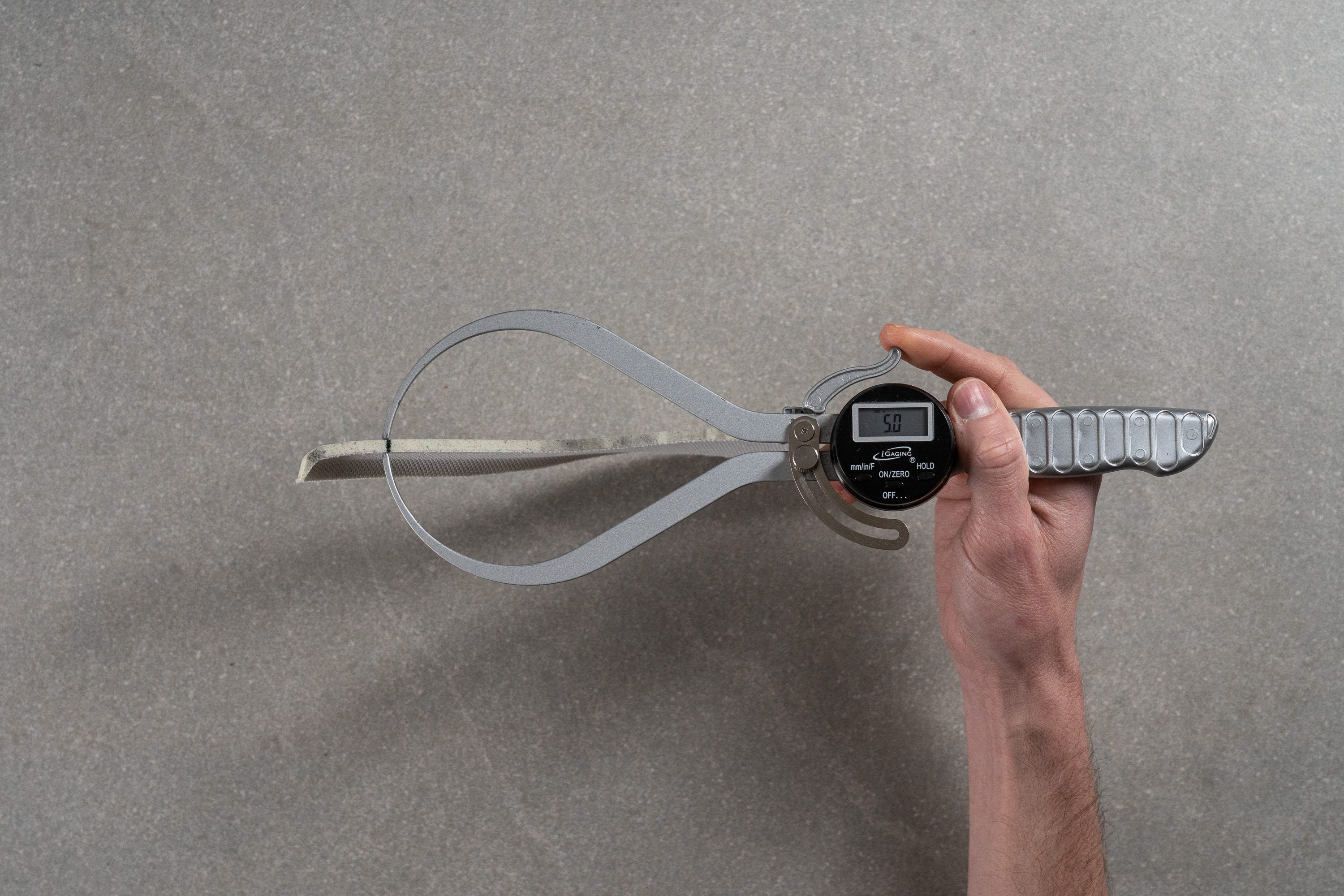
| Structure 25 | 5.0 mm |
| Average | 4.5 mm |
Removable insole
The Structure 25's insole is easily removed so it can easily be replaced with an after-market alternative or a custom orthotic for added arch support if necessary.
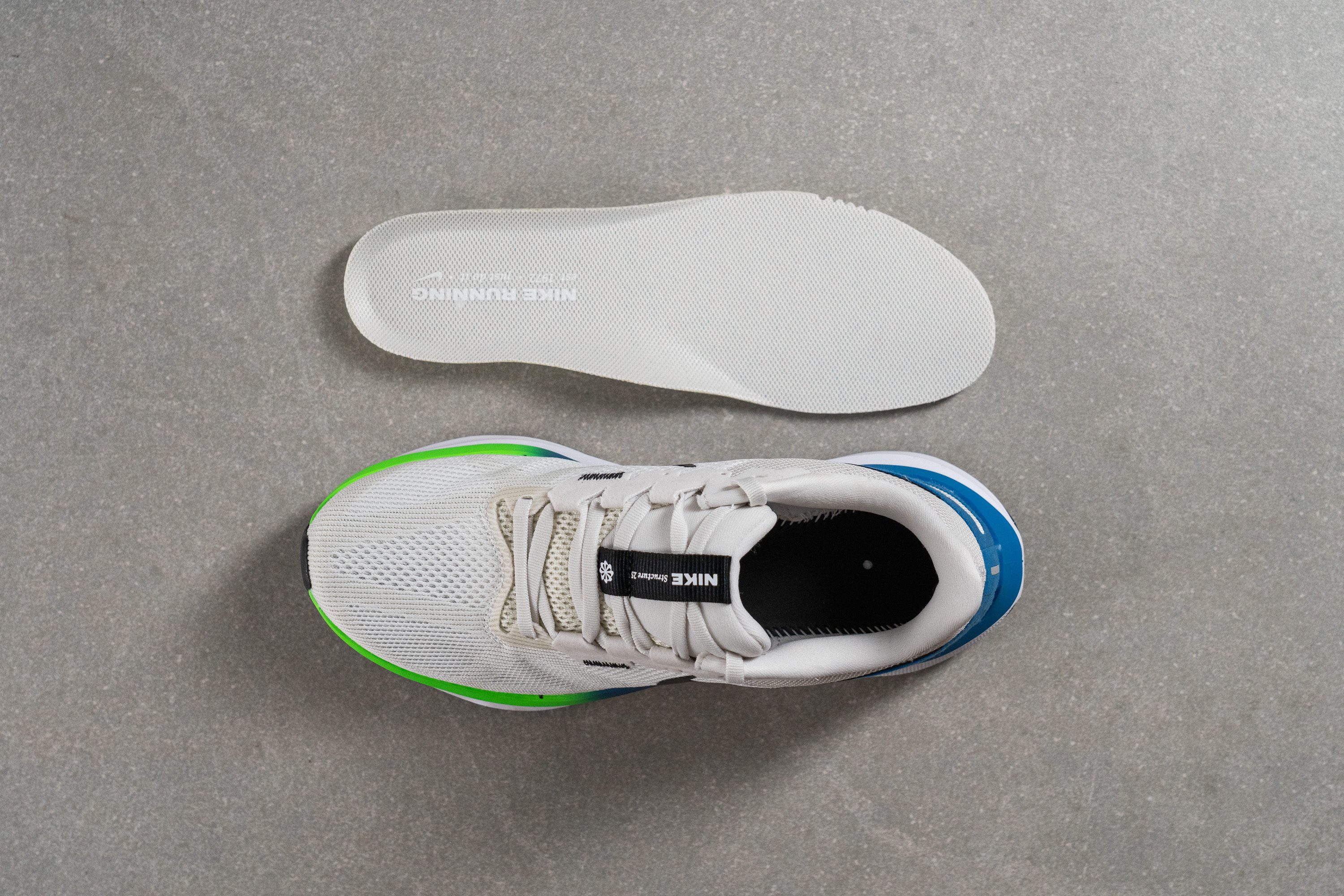
| Structure 25 | Yes |
Midsole softness in cold (%)
We placed the Structure 25 in our freezer to observe the effects of cold conditions on the midsole.
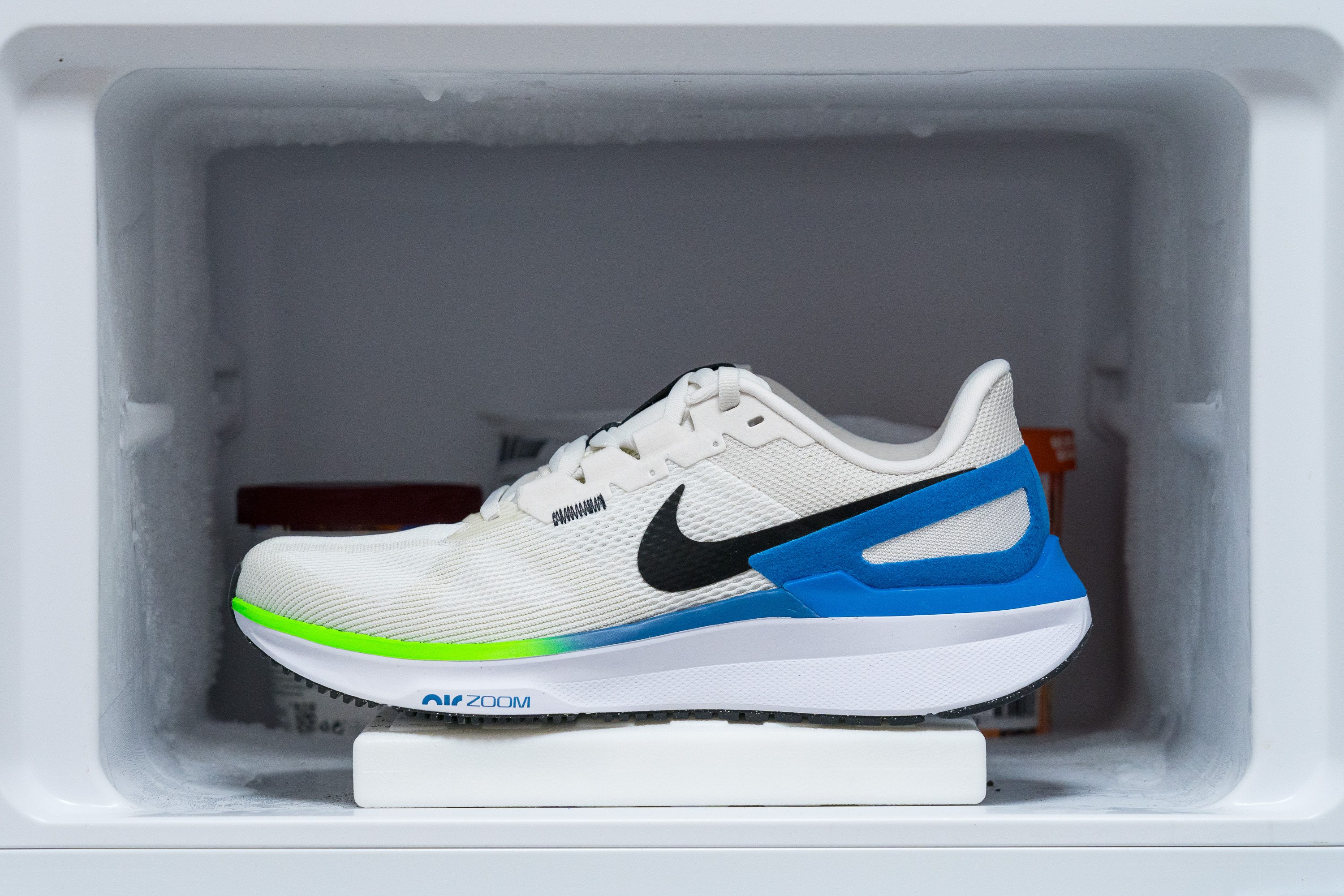
After twenty minutes of chilling, we pressed our durometer against the Cushlon 3.0 once more and found that it only got 17.6% firmer. This is quite consistent compared to our current lab average and, with a post-freezer reading of 20 HA, the Structure 25 should still feel comfy and forgiving underfoot no matter how cold it gets.
| Structure 25 | 18% |
| Average | 24% |
Reflective elements
The Structure 25 features a small reflective streak at the heel that provides some, albeit minimal, nighttime visibility. We still recommend using additional high-vis gear whenever taking this shoe out for a nocturnal romp.
| Structure 25 | Yes |
Tongue padding
At 11.8 mm thick according to our caliper measurements, the Structure 25's tongue is much beefier than our current lab average. As such, we experienced an incredibly luxurious lockdown once we were laced up and ready to go, with the laces themselves sinking into the pillowy tongue and virtually disappearing from our consciousness.
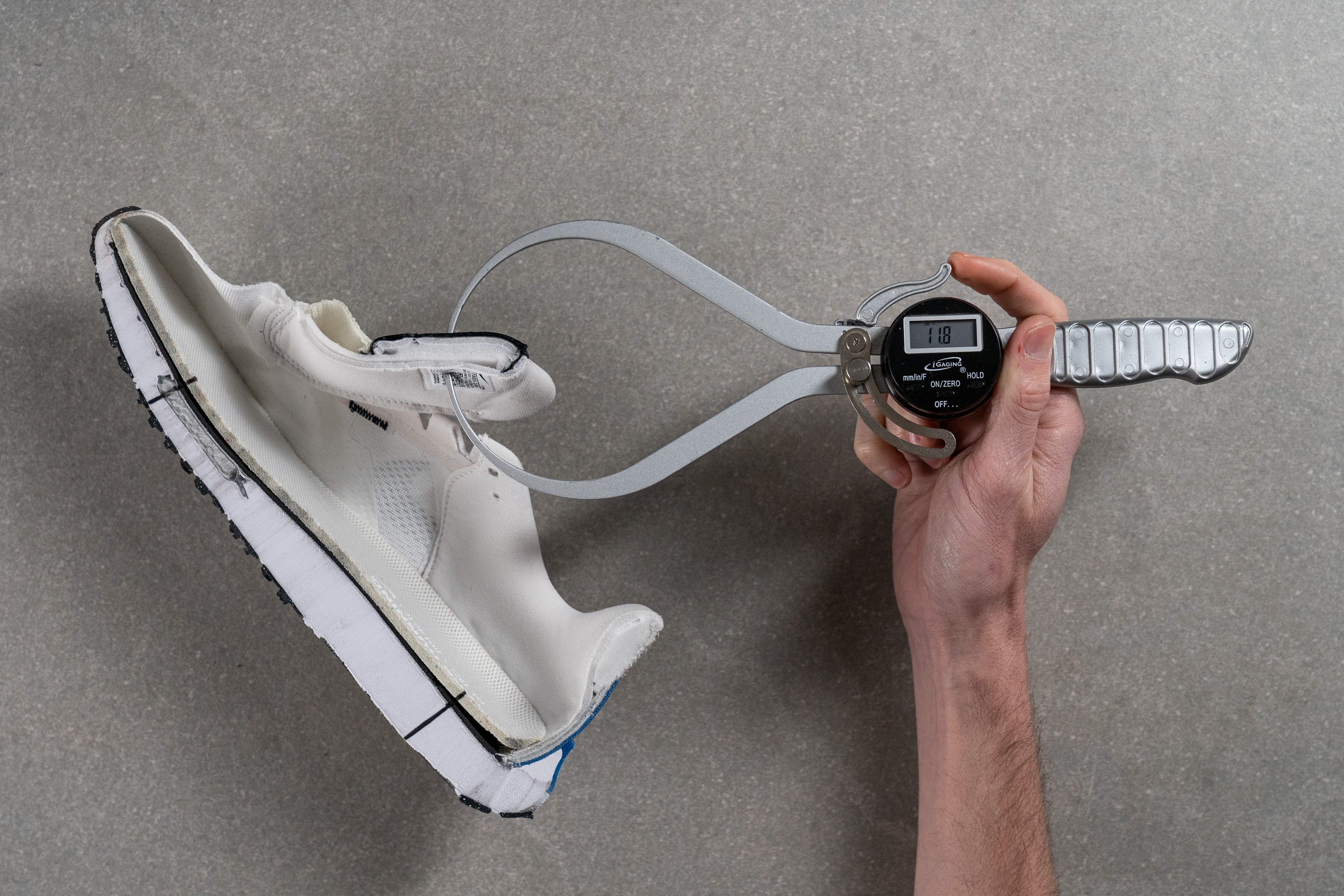
| Structure 25 | 11.8 mm |
| Average | 5.8 mm |
Tongue: gusset type
Despite being non-gusseted, we didn't experience any issues with the tongue slipping from side to side as we tested the Structure 25.
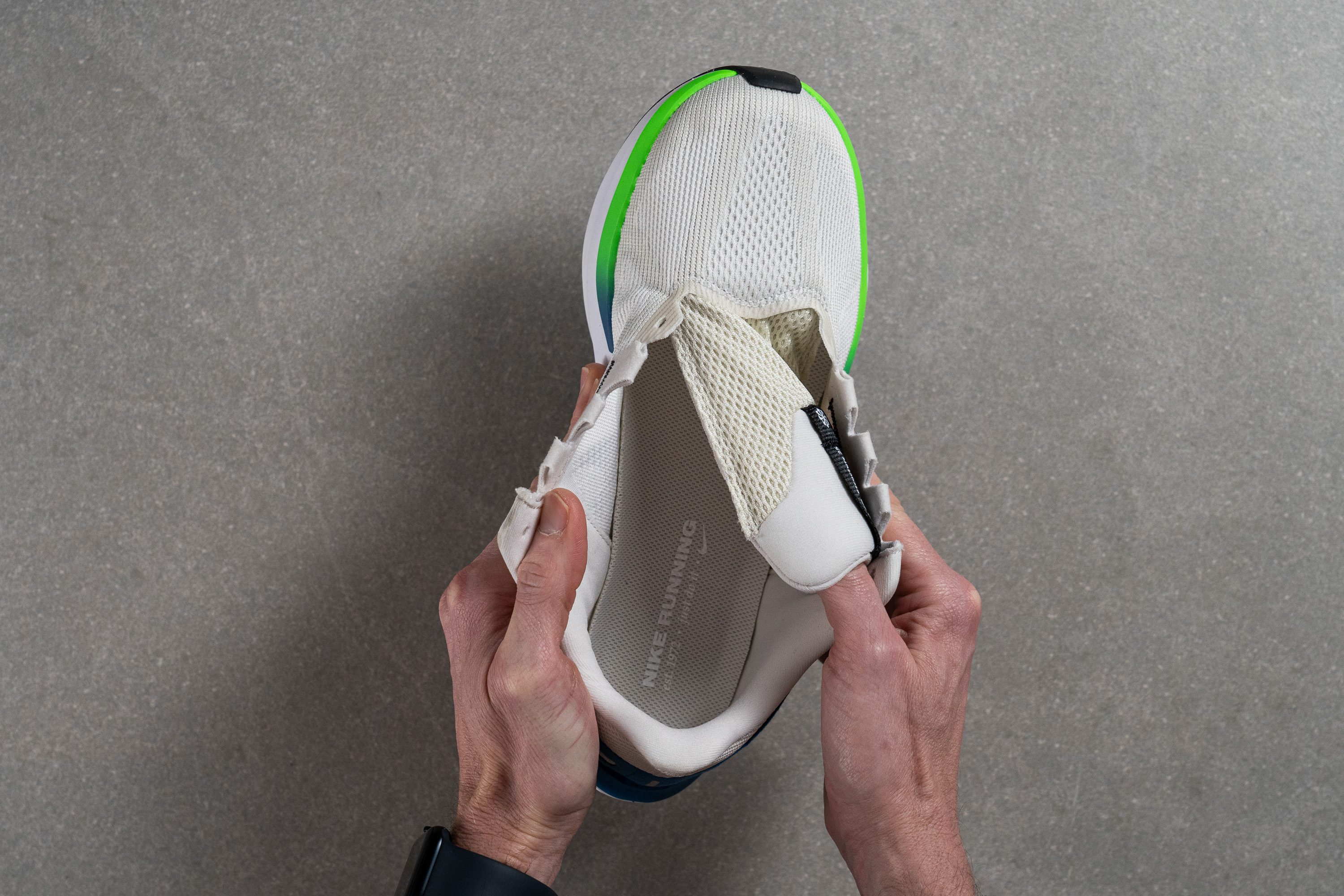
This is thanks to its chunky nature and the long central lace loop that helps mitigate slippage.
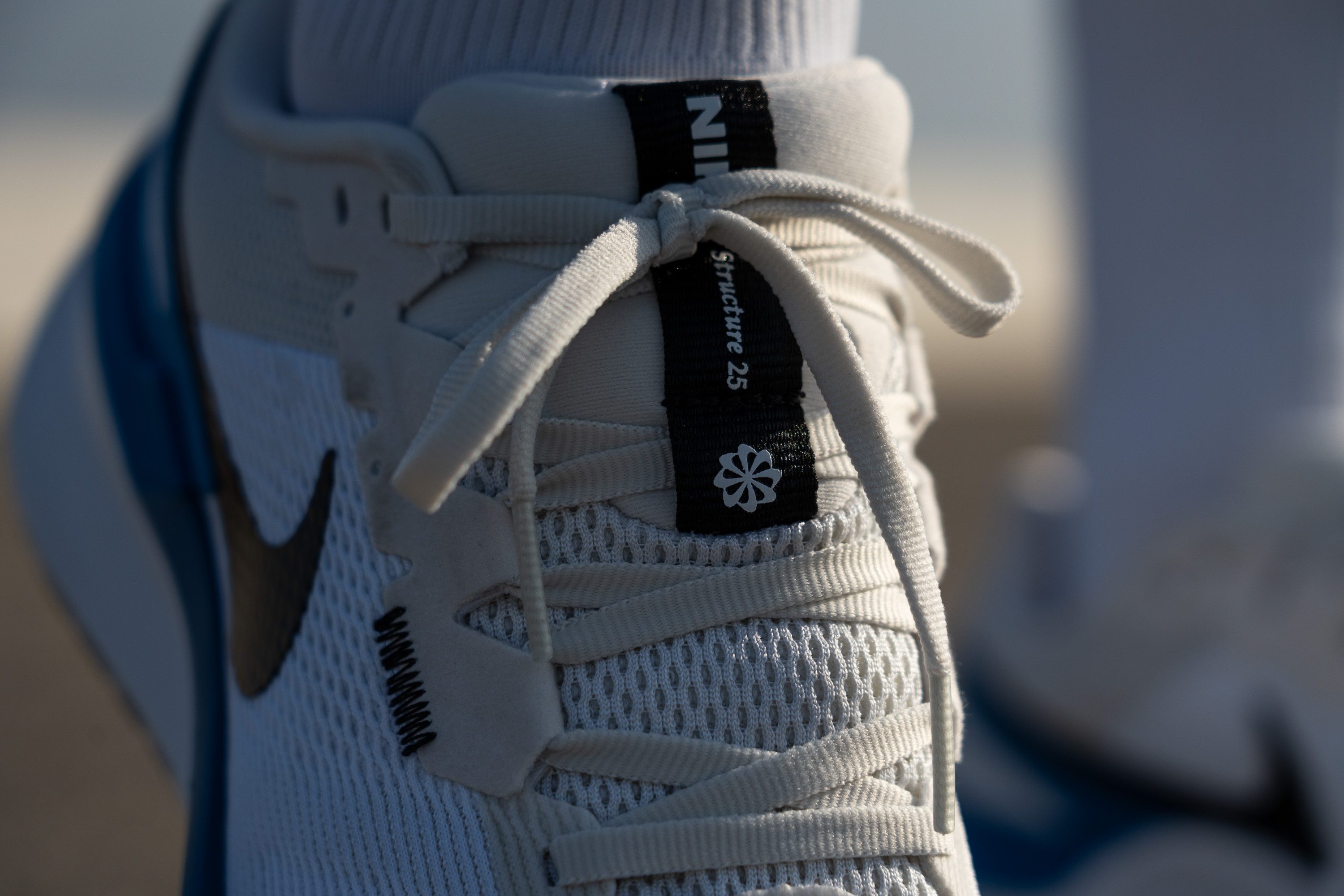
| Structure 25 | None |

